Physical Address
304 North Cardinal St.
Dorchester Center, MA 02124
The term rheumatic disease refers to any illness characterized by pain and stiffness in or around the joints. These diseases are divided into two main groups: disorders that involve the joints primarily (the different forms of arthritis) and disorders that, although not directly affecting the joints, involve connective tissue structures around the joints (the periarticular disorders, or nonarticular rheumatism). The many types of arthritis and nonarticular disorders differ from one another in etiology, pathogenesis, pathology, and clinical features. The focus of this section is on the more commonly encountered rheumatic conditions.
Rheumatoid arthritis and osteoarthritis (also called degenerative joint disease) are the most common forms of arthritis. Both of these chronic conditions are characterized by pain, stiffness, restricted joint motion, joint deformities, and disability, but their differences in pathogenesis, pathology, and clinical features must be distinguished because the prognosis and treatment of the two diseases differ.
Rheumatoid arthritis is a chronic, inflammatory systemic illness with widespread involvement of connective tissue. Although rheumatoid arthritis may begin at any age, onset is usually in the fourth or fifth decade. Occurring in all parts of the world, it affects females two to three times more often than males.
The major characteristic of rheumatoid arthritis is inflammation of multiple joints (polyarthritis), usually the joints of the limbs. Although partial remissions are common, relapses and progression of active disease are common. If unchecked, the joint inflammation causes irreversible damage to the articular cartilage and bone, resulting in joint deformity and disability.
There are one to two layers of the synovial lining cells in the synovium in normal joints, which mainly consist of two types of synovial lining cells (also called synoviocytes): type A (macrophage-like cells) and type B (fibroblast-like cells). Type C cells are synovial dendritic cells. In contrast, rheumatoid joint synovium becomes thickened, with more than three layers of synoviocytes. In addition to the synoviocytes, cell infiltrates including neutrophils, lymphocytes, and plasma cells also contribute to the synovial hypertrophy. The synoviocytes, neutrophils, and lymphocytes together constitute synovial cells, which produce numerous pathogenic molecules leading to the disease process in the rheumatoid synovium. Among the molecules are numerous cytokines that play important pathogenic roles. Proinflammatory cytokines, including tumor necrosis factor-α (TNF-α), interleukin-1β (IL-1β), and interleukin-6 (IL-6), have been extensively studied and confirmed to be pathogenic. On the basis of these proinflammatory cytokines, several biologic agents that target these cytokines have been developed and have been approved to treat rheumatoid arthritis. These agents include TNF-α inhibitors or blockers such as etanercept (Enbrel), adalimumab (Humira), infliximab (Remicade), and golimumab as well as the IL-1 antagonist anakinra (Kineret) (see later section on therapy for rheumatoid arthritis). In the rheumatoid synovium there are other cytokines, such as IL-17, IL-18, and lymphotoxin-β that could be potential therapeutic targets in the future. In addition, other molecules such as chemokines are found to be involved in the rheumatoid disease process. These chemokines bind to their receptors CXCR3 and CCR5 to recruit inflammatory cells to the sites of the joint inflammation.
The evolution of the pathologic changes in the joint provides the key to understanding the clinical nature of the disease (see Plate 5-1 ). In the rheumatoid joint, synovitis, the inflammation occurring in the synovium, represents a basic inflammatory disease. The synovial membrane becomes edematous and infiltrated primarily with neutrophils and mononuclear cells. This produces diffuse synovial proliferation, and synovial fluid accumulates. In this early stage, the articular cartilage and subchondral bone are not involved. As the disease progresses, the inflamed synovium continues to proliferate and villous projections grow into the joint cavity (villous synovitis). The villi become infiltrated with lymphoid cells, which may form follicular collections. The proliferations spread along the cartilage surface (pannus formation), eroding and thinning the cartilage. The proliferative inflammation often invades the subchondral bone. Osteoporosis develops in the metaphyseal bone, weakening it, sometimes enough to cause erosion of the supporting cortical bone and thus disrupt the joint.
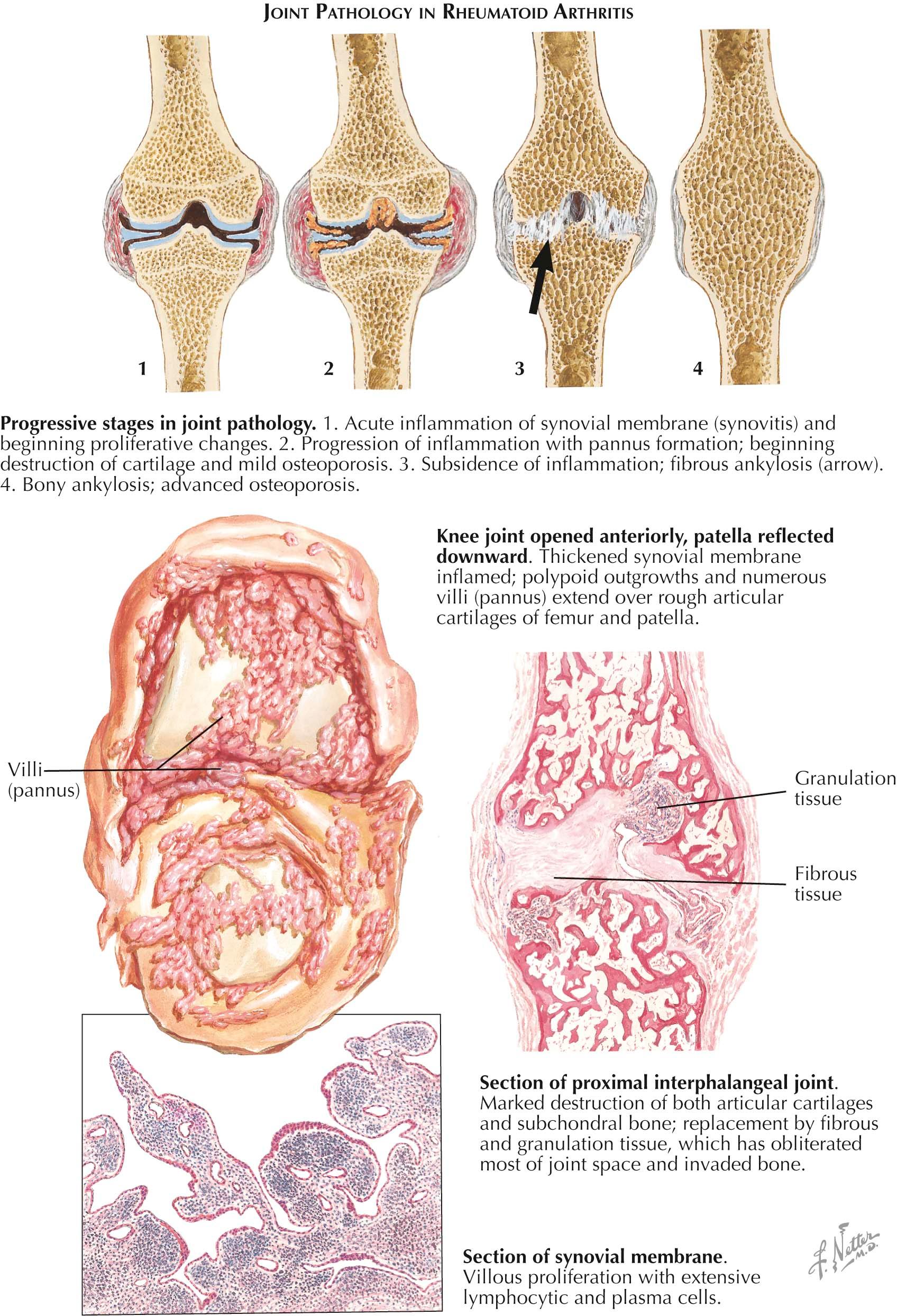
As the disease becomes more chronic, fibroblasts infiltrate the inflamed joint capsule, which becomes thickened and boggy. The pannus progresses, causing more destruction and joint deformity. The progressive inflammation causes irreversible destructive changes in cartilage and bone. After months or years of periods of active disease and partial remissions, even if the inflammation subsides, fibrous tissue has often increased and further restricts motion, leading to fibrous ankylosis. The stiffened, deformed joint may become solidly fused by bony bridges across the joint space; this final stage is thus called bony ankylosis, clinically manifested as advanced secondary osteoarthritic change. Pain lessens as the inflammation subsides, but the joint damage persists, accounting for the stiffened and deformed joints, disability, and incapacitation.
The synovial proliferation along with the microvascular process called angiogenesis may behave like a benign tumor, which is partly caused by defects of some apoptotic genes and their molecules. Based on these molecules, researchers have studied intra-articular gene delivery of vectors carrying such apoptotic molecules as P53 , FasL , and TRAIL to mimic surgical synovial ablation, termed molecular synovectomy.
Early in the course of the illness, joint involvement is characterized by signs and symptoms of polyarthritis in the limbs, usually in a symmetric distribution. In pauciarticular (oligoarticular)-onset rheumatoid arthritis, only one or a few joints are involved. The affected joints become diffusely swollen, warm, and tender. Joint movement is painful, and the swelling of the joint capsules creates a feeling of stiffness. Generalized stiffness is also noted after long periods of inactivity, especially on arising in the morning. Depending on the severity of the illness, morning stiffness may last 1 to 2 or even longer hours, making routine daily activities difficult. Even early in the illness, the patient may be partially incapacitated.
Although the progression of joint inflammation follows no fixed pattern, usually several pairs of joints in the limbs are affected first. After months or even years, other joints may become involved, including the acromioclavicular, sternoclavicular, and temporomandibular joints, and even tiny joints such as the cricoarytenoid articulations. It is common, however, for some joints to be spared even if the disease remains active for many years and the joints involved early undergo severe crippling changes. The factors that determine the distribution of the disease and the severity of the inflammatory process in any joint remain unexplained.
The joints of the hands and wrists are among the most frequent sites of involvement (see Plate 5-2 ). In the fingers, some or all of the proximal interphalangeal joints are often bilaterally affected whereas the distal interphalangeal joints are seldom involved. Because the inflammatory swelling occurs only at the middle joints, the affected fingers become fusiform in the early stages of disease. The metacarpophalangeal and wrist joints may also become inflamed. At first, there is little restriction of motion in the involved joints, but stiffness, swelling, and pain prevent the patient from making a tight fist, thus weakening grip strength. Except for soft tissue swelling, radiographs reveal no abnormalities.
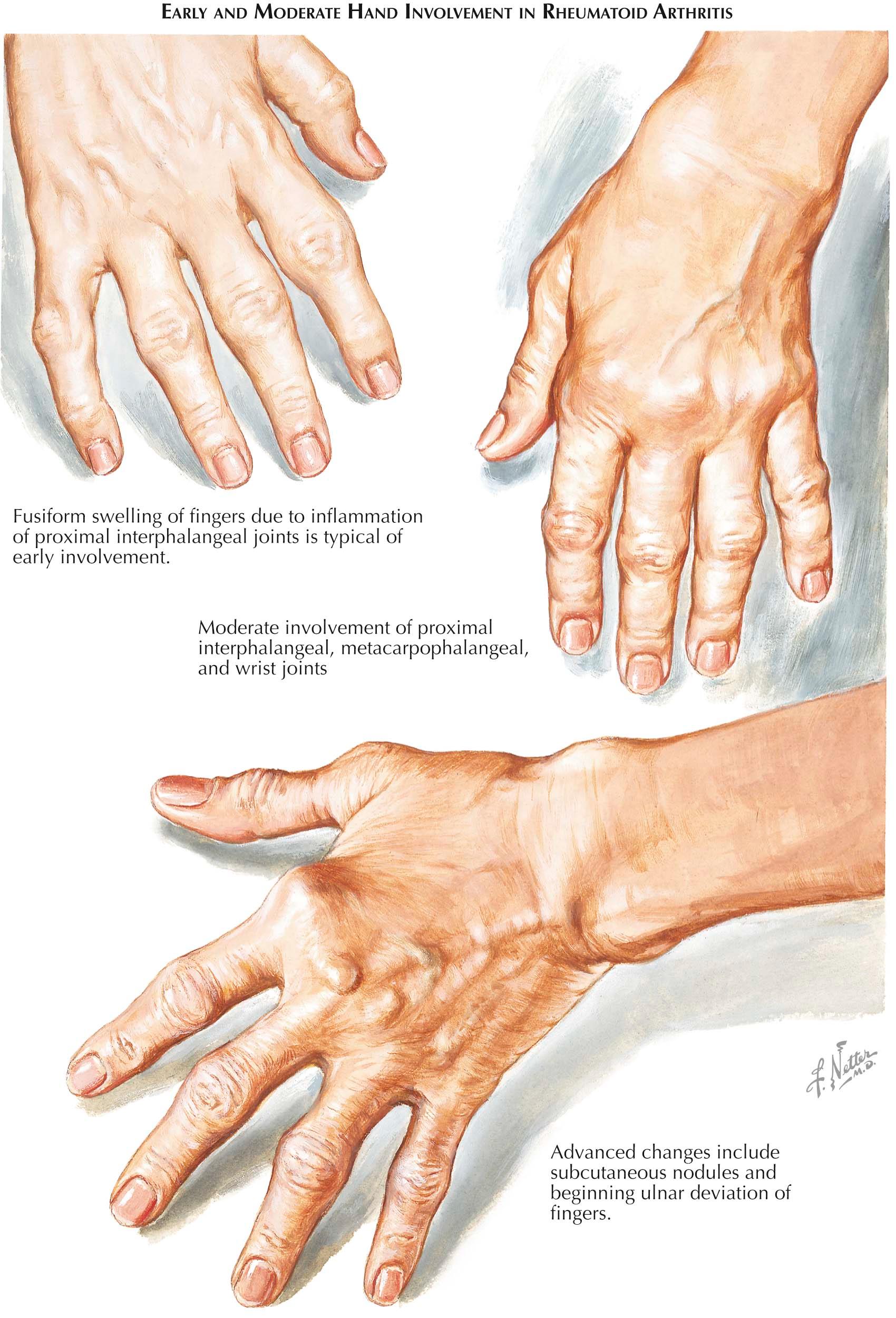
As the disease progresses and the inflammation invades the joints, destroying articular cartilage and bone, joint motion becomes severely limited and joint deformities develop (see Plate 5-3 ). Flexion deformities frequently occur at the proximal interphalangeal and metacarpophalangeal joints. The patient cannot fully extend or flex the fingers, and the grip becomes progressively weaker. Radiographs reveal cartilage thinning, manifest as joint space narrowing, bone erosions at the joint margins, and metaphyseal (periarticular) osteoporosis. After years of chronic inflammation, joint damage becomes severe; the joint capsule stretches; muscles atrophy and weaken; and tendons stretch, fray, and even rupture. All of these changes result in severe, incapacitating deformities.
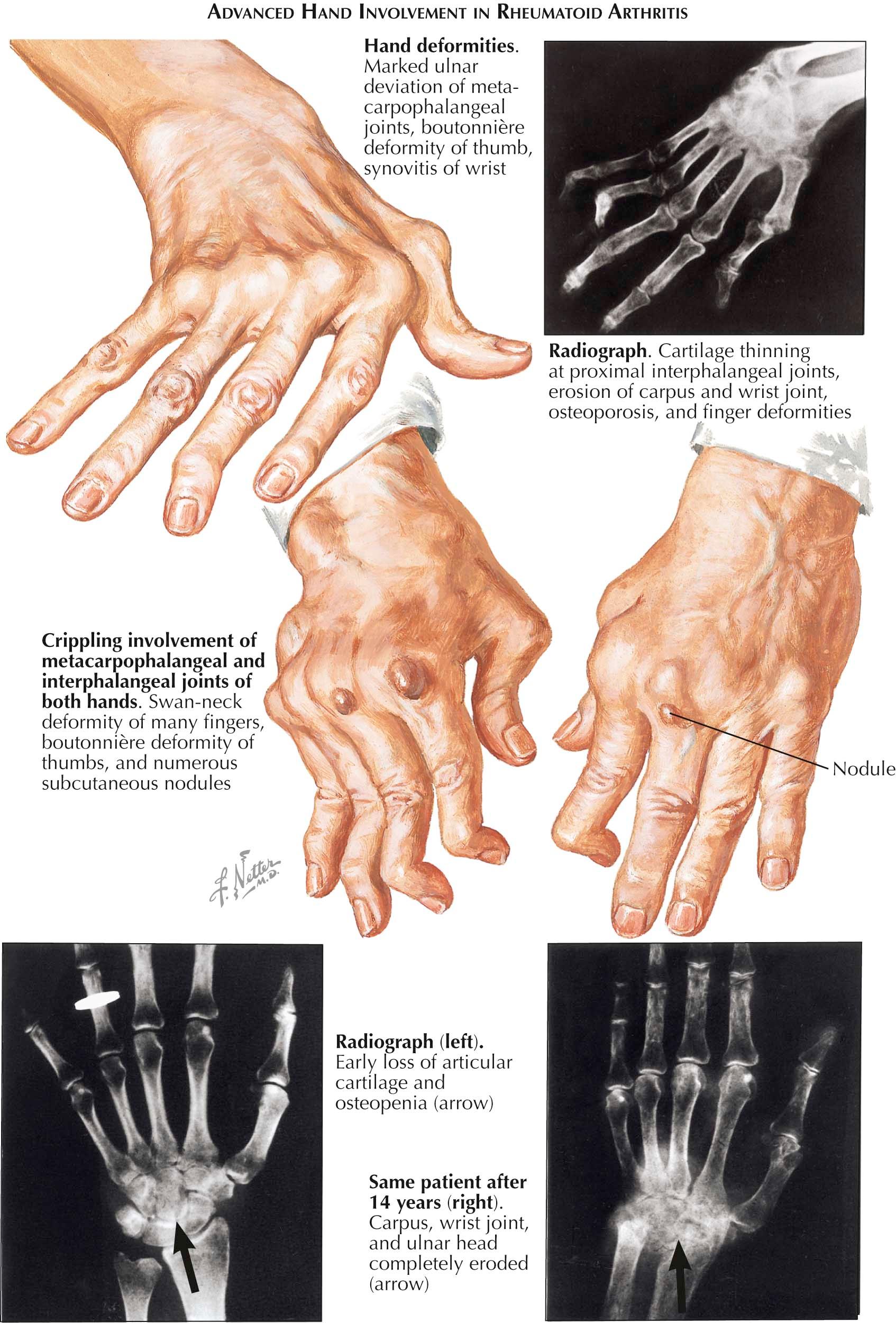
A number of hand deformities are seen in the late stages of rheumatoid arthritis. For example, the muscles on the ulnar side of the fingers and wrist may overpower those of the radial group, causing ulnar deviation of the fingers at the metacarpophalangeal joints; the wrists may also be affected. The swan-neck deformity of the finger is common, as is the boutonnière deformity of the thumb, which is caused by hyperextension of the proximal interphalangeal joint and flexion at the metacarpophalangeal joint. The long extensor tendon may rupture near the distal interphalangeal joint, leaving the distal phalanx permanently flexed. Prolonged disease may lead to permanent subluxation or dislocation of the finger joints, and severe cartilage and bone erosion at the wrist may literally destroy the carpus. In this late stage of the disease, radiographs help to define the severity of the structural damage and deformities.
Joint involvement in the foot resembles that in the hand, except for deformities that are determined chiefly by the foot's weight-bearing function (see Plate 5-4 ). The toes usually become hyperextended, or cocked up, at the metatarsophalangeal joints and flexed at the proximal interphalangeal articulations (hammertoes). The joint capsules, fasciae, and tendons become stretched and weakened, and the metatarsal and longitudinal arches flatten. Standing and walking exert great pressure on the osteoporotic metatarsal heads, causing severe erosion of the metatarsals. Frequently, plantar callosities develop under the metatarsal heads. Hallux valgus with bunion formation is also common. Cartilage thinning of the intertarsal joints is usually so severe that the tarsus becomes quite rigid, adding strain to the inflamed ankle joint. These structural changes make walking both difficult and painful.
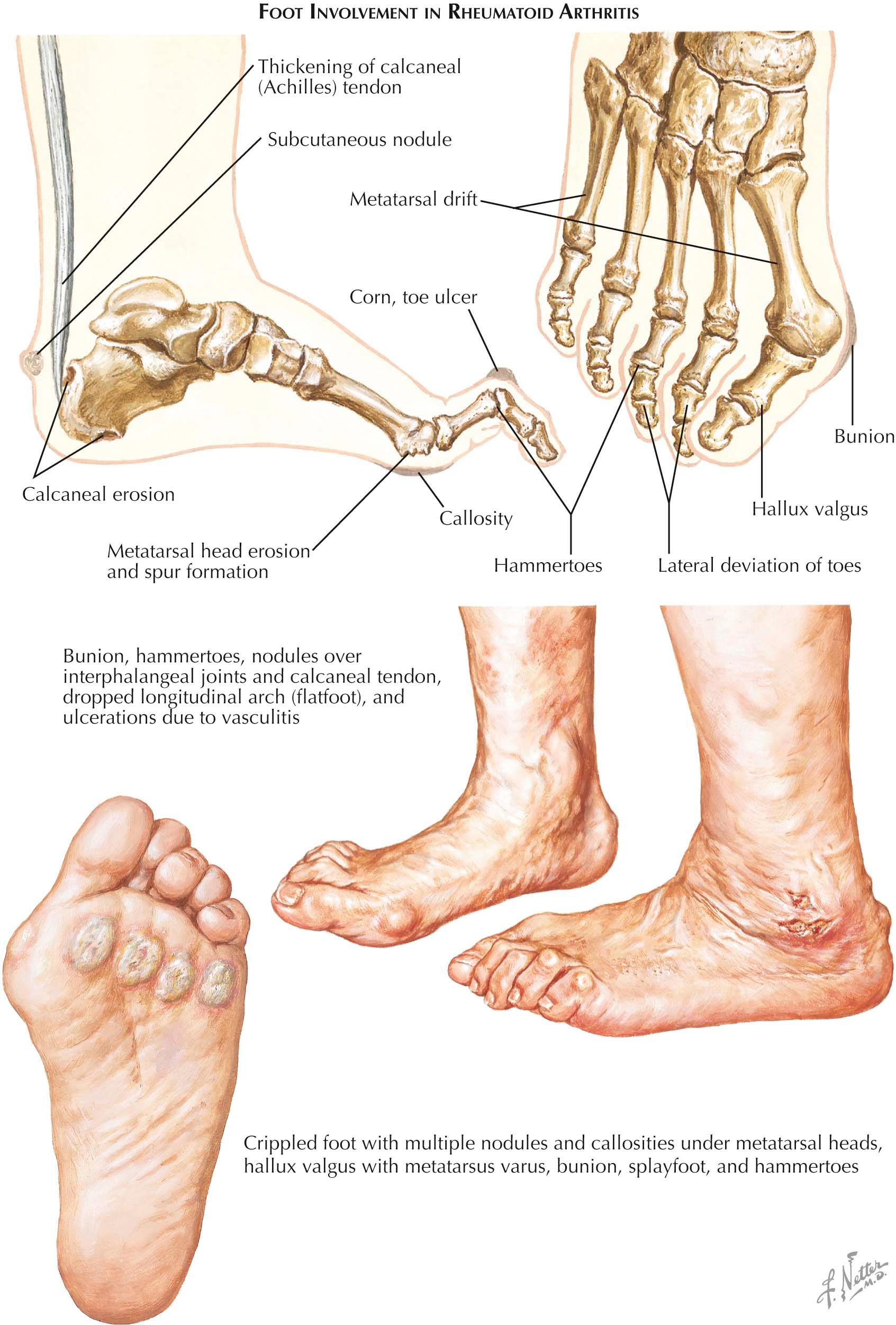
Inflammation of the large joints of the limbs causes a boggy and diffuse swelling of the soft tissues of the joints. In the elbows and knees, this swelling is easily observed on physical examination (see Plate 5-5 ). Involvement of the hip and shoulder joints, on the other hand, cannot be detected by inspection and palpation because the hips and, to a lesser degree, the shoulders lie deep beneath the skin and are well covered by fleshy muscles. Examination for range of motion elicits pain and restricted movement if the joints are inflamed. In these large, well-covered joints, radiographs are required to evaluate the damage to the articular cartilage.
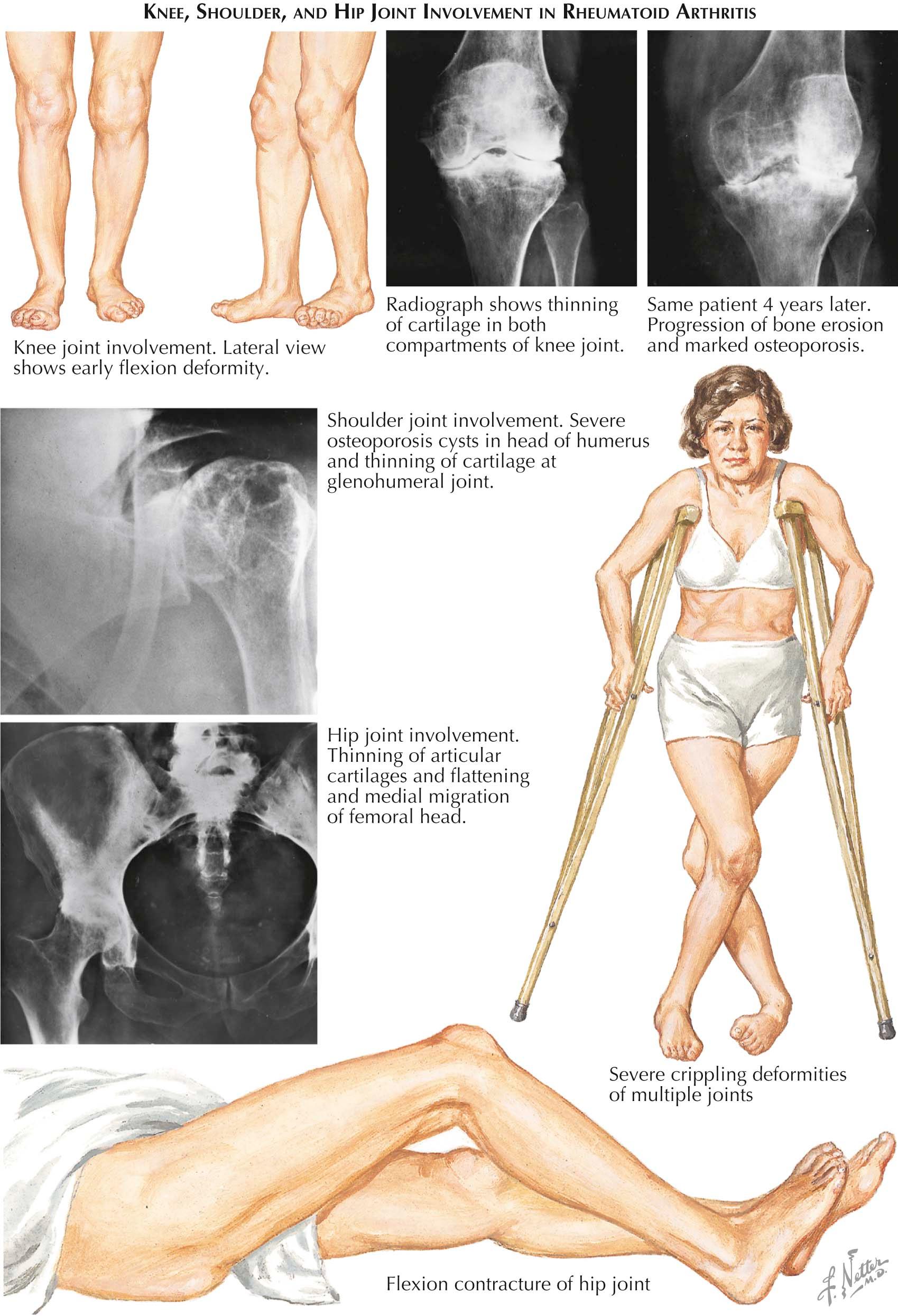
Flexion deformities can develop quickly at the knees and hips, making walking and arising from a sitting position difficult and painful. Extensive damage to the large joints in the limbs may cripple the patient, necessitating use of a cane, crutch, or walker or confinement to a wheelchair or a bed.
Rheumatoid arthritis is a systemic illness, not just a disease of the joints, and thus has a variety of nonarticular, or extra-articular, manifestations (see Plates 5-6 and 5-7 ). Some of these features are occult, with little clinical importance, but others are clinically significant. In some cases, extra-articular features are the dominant clinical signs.
Rheumatoid inflammation may be nodular or diffuse and may occur in parenchyma and connective tissues throughout the body. It therefore produces a variety of pathologic lesions in many locations. The inflammation of the nonarticular connective tissue has the same characteristics as the synovitis: it is a proliferative inflammatory reaction containing lymphocytes, macrophages, and plasma cells. The lymphocytes often cluster in a follicular pattern.
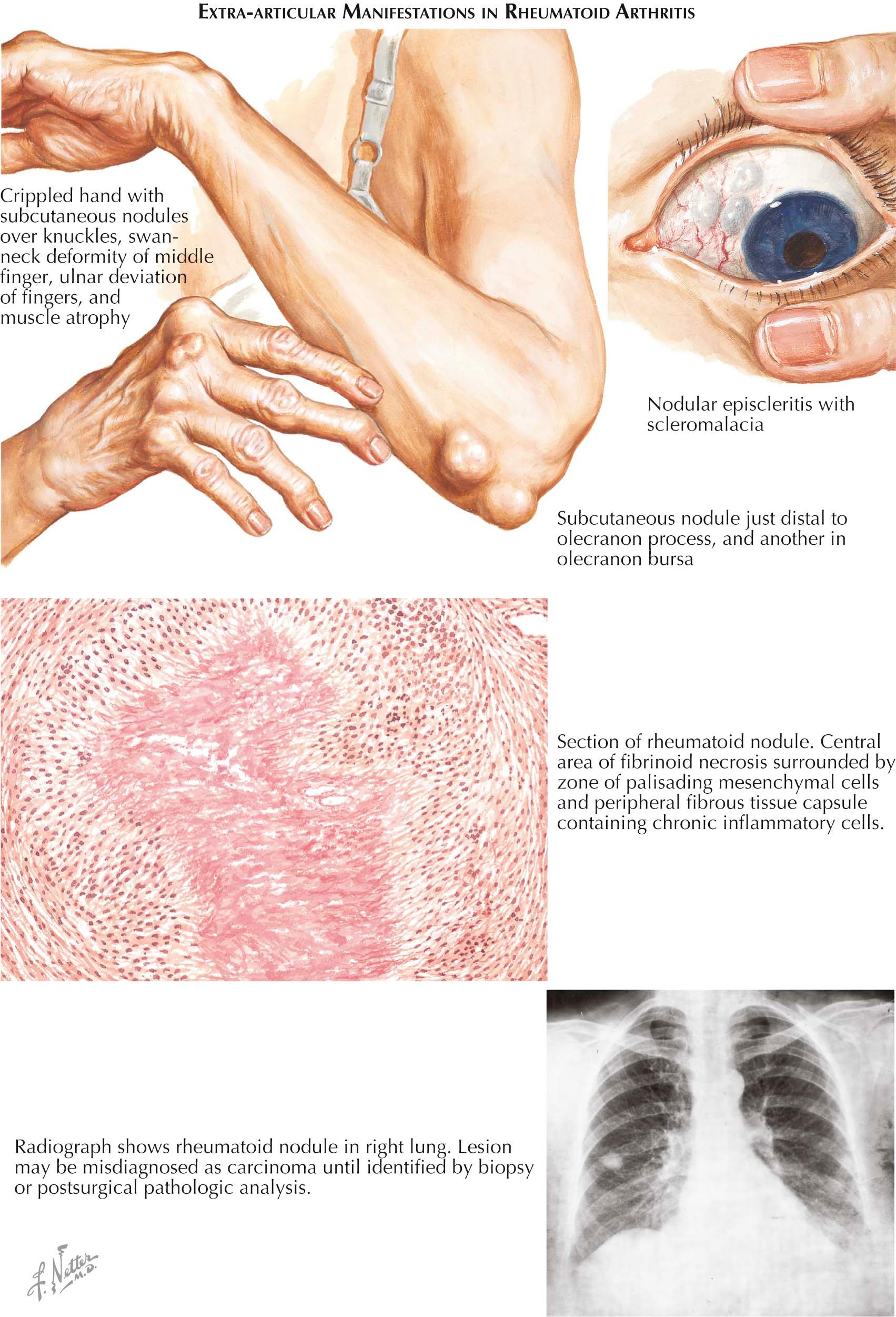
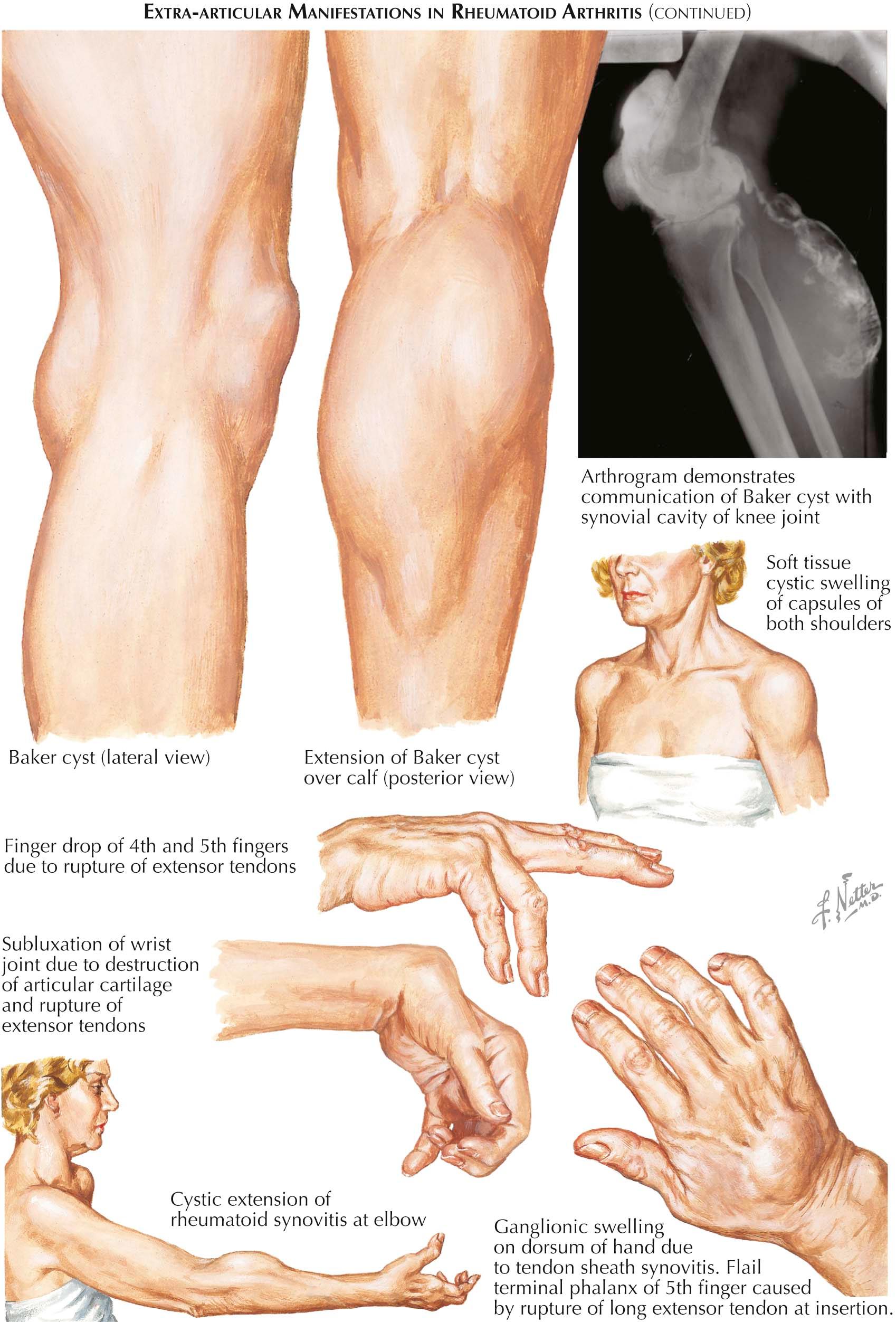
Rheumatoid Nodules. In about 15% of cases, nodules develop in connective tissue along tendons, at tendon sheaths, in bursa and joint capsules, and in the subcutaneous connective tissue around bony prominences (see Plate 5-6 ). A common place for nodules to occur is a few centimeters distal to the olecranon process of the ulna. The nodules in subcutaneous tissue are freely movable, whereas those that originate in the periosteum are firmly attached to the underlying bone. Rheumatoid nodules occur singly or in aggregate in clusters, and they vary from 1 mm to more than 2 cm in diameter.
When surrounded by soft tissue, rheumatoid nodules are painless, but nodules located over bony prominences are often painful when pressure is exerted on them. For example, nodules around the ischial tuberosity cause pain when the patient sits on a firm seat and nodules over spinous processes or the occipital protuberance make lying supine on a firm surface painful. Similarly, those occurring on the plantar surface of the foot cause discomfort when standing or walking. Nodules located over the knuckles, toes, or knees may restrict motion in the underlying joint.
The presence of rheumatoid nodules greatly aids in the diagnosis of rheumatoid arthritis because they occur with no other form of chronic arthritis. However, nodular swellings near joints and along the border of the ulna are associated with other illnesses (e.g., urate deposits, or tophi, in gout). If the nature of the nodular swelling and the diagnosis of rheumatoid arthritis is not clear, excision and microscopic study of the tissue is advised. Characteristic histopathologic features of rheumatoid nodules are (1) a central zone of fibrinoid degeneration surrounded by (2) an intermediate zone of palisading epithelioid cells and (3) an outer coat of granulation tissue infiltrated with lymphocytes and plasma cells.
Pulmonary Involvement. Rheumatoid nodules may develop in the parenchyma of the lung (see Plate 5-6 ). On radiographs, a solitary nodule often cannot be differentiated from a neoplasm, nodules are generally located in subpleural areas or in association with interlobular septa, but histologic study of the lesion reveals the pathologic features of a rheumatoid nodule. Medications such as methotrexate can cause pulmonary nodules, which are usually located in the middle zones of the lungs. TNF-α inhibitors, used to treat rheumatoid arthritis, can rarely cause lung nodules. Other parenchymal lung diseases (e.g., interstitial fibrosis, pulmonary nodules, and bronchiolitis obliterans/organizing pneumonia) can occur. Caplan syndrome is a unique form of pneumoconiosis that may be a granulomatous response to chronic exposure to silica dust. It is especially prevalent in coal miners. Widely distributed and particularly prevalent in the periphery, the nodules usually appear abruptly, with little or no evidence of prior pneumoconiosis. They may occur before, during, or after the onset of arthritis. Patients with Caplan syndrome usually have a high serum titer of rheumatoid factor. Progressive interstitial fibrosis and pleurisy with or without effusion are other pulmonary manifestations of rheumatic disease.
Cardiac Involvement. In the myocardium, rheumatoid nodules may cause cardiac conduction defects. Pericarditis may occur but is rarely symptomatic; if effusion develops, the fluid, like rheumatoid pleural effusion, has a very low sugar content. This characteristic effusion is a helpful diagnostic finding. Constrictive pericarditis and valvular granulomatous lesions (usually aortic) are rare.
Ocular Changes. About 30% patients with rheumatoid arthritis have features of Sjögren syndrome, called secondary Sjögren syndrome. Keratoconjunctivitis is commonly associated with rheumatoid arthritis. Granulomatous scleritis occurs less often but may lead to scleromalacia perforans (see Plate 5-6 ).
Nervous System Involvement. The dura mater is another site of rheumatoid nodules. A more frequent clinical manifestation, however, is peripheral neuropathy due to inflammation in the arterioles supplying the nerve. Peripheral nerve compression from localized articular or nonarticular inflammation surrounding the nerve (e.g., compression of the median nerve in carpal tunnel syndrome) is also common. Ulnar neuropathy and radial nerve palsy are seen less often.
Periarticular Fibrous Tissue Manifestations. In many cases, the inflammation affects specialized periarticular fibrous tissue structures, most commonly, tendons, tendon sheaths, and bursae (see Plate 5-7 ). The periarticular inflammation has the same proliferative and invasive characteristics as synovitis. Tendonitis and tenosynovitis may cause the tendon to rupture; and in some patients, the periarticular inflammation causes as much pain, stiffness, and disability as the arthritis. Muscle weakness and atrophy occur in late stages of rheumatoid arthritis.
Rheumatoid Vasculitis. Now recognized as a major manifestation of rheumatoid arthritis, vasculitis is classified by pathologic changes into three main categories: (1) intimal proliferation of digital arteries causing ischemic areas in the nail fold, nail edge, or digital pulp; (2) subacute lesions in small vessels of muscles, nerves, heart, and other tissues; and (3) widespread fulminant necrotizing arteritis of medium-sized and large vessels. Leukocytosis, scleritis, neuropathy, mesenteric infarction, and ischemic skin ulceration or gangrene are commonly associated with occlusive or necrotizing arteritis.
Rheumatoid arthritis complicated by vasculitis is associated with severe and long-standing joint inflammation, elevated serum titers of rheumatoid factor, diminished serum complement levels, rheumatoid nodules and other extra-articular manifestations, and a poor prognosis. The detection of IgG, IgM, and complement components in the inflamed arterial wall supports the hypothesis that rheumatoid vasculitis is due to the deposition of soluble immune complexes in the vessel wall (see Plate 5-8 ).
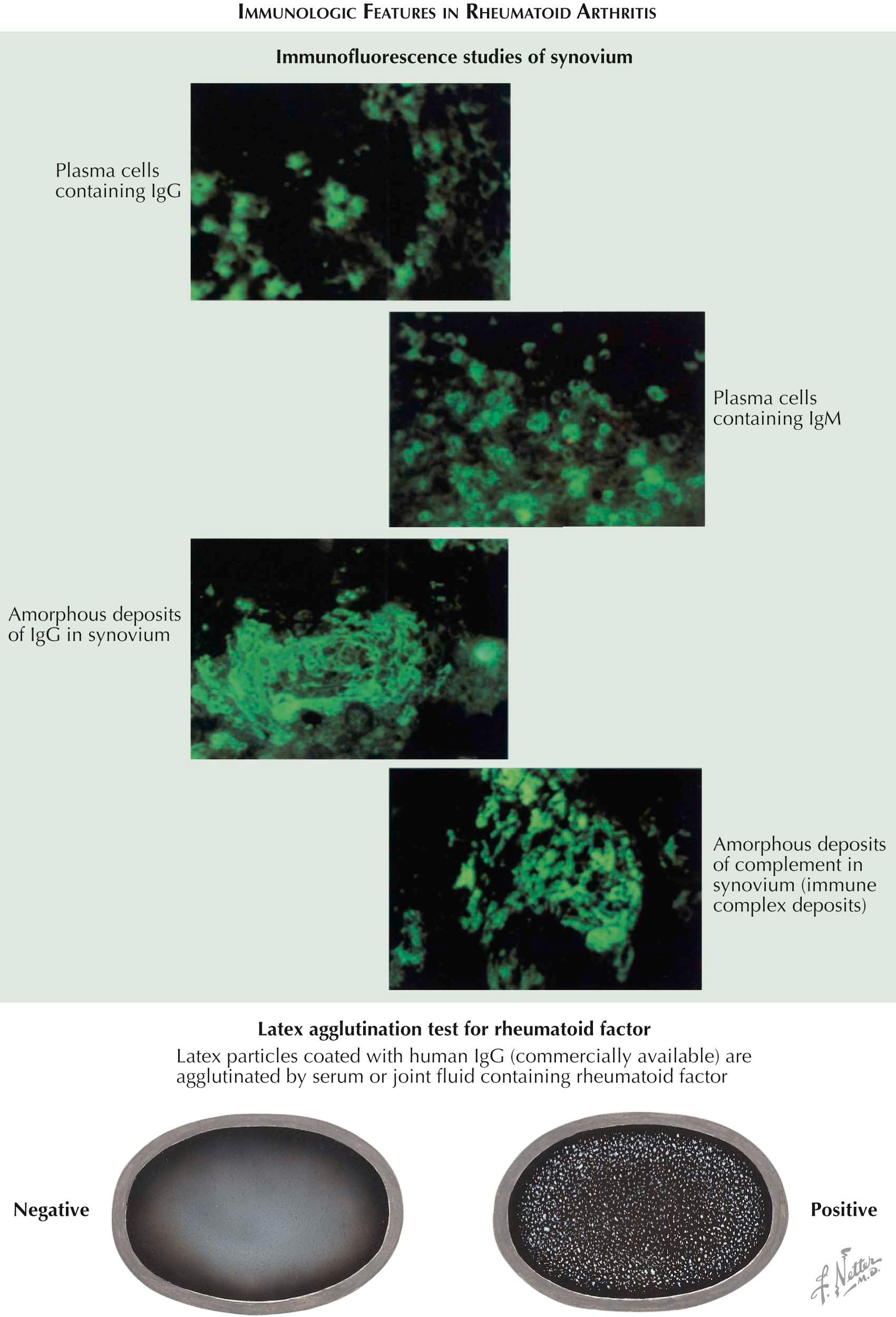
Other Manifestations. Mild-to-moderate anemia is typical of active disease, with the exception of mild cases, and is largely due to a relative failure of bone marrow production because of increased uptake and abnormal storage of iron by the reticuloendothelial system and the phagocytic cells of the inflamed, hyperplastic synovial membrane. Unless an iron deficiency supervenes, the erythrocytes are normocytic and only slightly hypochromic. Impaired absorption of iron from the gastrointestinal tract and, in some cases, bleeding into the gastrointestinal tract caused by nonsteroidal anti-inflammatory agents or other therapeutic drugs also contribute to the development of anemia.
Osteoporosis in the metaphyses of bones adjacent to inflamed joints begins early and is termed periarticular osteopenia. This manifestation is caused by inflammatory cells and cytokines in the bone marrow that result in decreased bone formation. In advanced disease, especially when weight-bearing activity is curtailed, the osteoporosis becomes generalized and often severe.
Although generalized lymphadenopathy is a frequent finding, splenomegaly occurs in only about 5% of patients. When accompanied by leukopenia, the disorder is known as Felty syndrome. Leukopenia, if severe, may lead to serious infection. Other manifestations of Felty syndrome include rheumatoid nodules, chronic leg ulcers, peripheral neuropathy, thrombocytopenia, anemia (often severe), keratoconjunctivitis sicca, as well as increased myeloid activity and very high titers of rheumatoid factor. Felty syndrome should be differentiated from large granular lymphocyte syndrome. In the latter, peripheral blood analysis and bone marrow biopsy demonstrate typical large granular cells. T-cell receptor recombination studies can provide additional diagnostic evidence.
In the late stage of rheumatoid disease, secondary amyloidosis may occur, but this is relatively uncommon.
The serum of most patients with rheumatoid arthritis contains immunoglobulins, or antibodies. The autoantibodies to gamma globulin (IgG) are called rheumatoid factors. The latex fixation tests commonly used in the diagnosis of rheumatoid arthritis detect only the IgM class of rheumatoid factor, which is most prevalent; however, IgG and, to a lesser extent, IgA rheumatoid factors are also found. All classes of rheumatoid factor act as antibodies to IgG (which acts as antigen) to form immune complexes. In rheumatoid arthritis, some rheumatoid factor is produced in the synovium. Some of the IgG and IgM shown in plasma cells (see Plate 5-8 ) consists of rheumatoid factor. Immune complexes containing rheumatoid factor, IgG, and complement are prominent in vacuoles of synovial fluid cells as well as in synovial macrophages and interstitium. The immune complexes also appear to be important in extra-articular disease because they deposit in vessel walls and cause vasculitis. The latex agglutination test of rheumatoid factor has been replaced by the enzyme-linked immunosorbent assay (ELISA) in current clinical practice.
Citrullination is the term used for the post-translational modification of the amino acid arginine into the amino acid citrulline. Cyclic citrullinated peptides (CCP) are post-transcriptionally modified peptides, and their antibodies are called anti-CCP antibodies, which were introduced into clinical use in 1997. As with rheumatoid factors, anti-CCP antibodies aid in the diagnosis of rheumatoid arthritis and may be present before the appearance of symptoms of rheumatoid arthritis. Their presence is an indicator of rheumatoid disease severity. ELISA is widely used to detect the anti-CCP antibodies, and the sensitivity and specificity of the anti-CCP antibodies are 50% to 75% and over 90%, respectively. The newer-generation assays, including the second-generation anti-CCP antibody assays (anti-CCP2), have improved sensitivity and specificity compared with the original anti-CCP assays.
A genetic predisposition is an important factor in determining the immune response to the still-unknown initiating factors. The major histocompatibility complex class II antigen HLA-DR4 (HLA-DRB1*0401 and HLA-DRB1*0404/0408 by new nomenclature) is associated with an increased incidence of rheumatoid arthritis in many populations, but it is not present in all patients with rheumatoid arthritis. PTPN22 (protein tyrosine phosphatase N22) has been associated with rheumatoid arthritis as well, although about 17% of the normal white population also have this missense gene mutation.
Analysis of synovial fluid shows pathologic changes characteristic of rheumatoid arthritis: increased volume and increased leukocyte count (>10,000/mm 3 ), with a preponderance of mononuclear or polymorphonuclear cells at different stages of disease and in different patients. Activated T lymphocytes are commonly present. There is poor viscosity due to diluted and denatured hyaluronate and low complement levels. Synovial fluid leukocytes often contain inclusion particles that are made up of IgG, rheumatoid factor, and complement. Many of the modulators of inflammation discussed earlier can be identified in joint fluid in rheumatoid arthritis but are not routinely measured.
Thrombocytosis, elevated erythrocyte sedimentation rate (ESR), and C-reactive protein (CRP) usually correlate with the rheumatoid disease activity rather than disease severity. These laboratory tests are thus of some value in monitoring the course of the illness.
Although the etiology of rheumatoid arthritis is not yet understood, the following four factors—genetic background, abnormal immunity, environmental, and sex hormones—may play a role in concert with one another. Many causative factors have been proposed, including infectious microorganisms such as bacteria, mycobacteria, Mycoplasma, and their components and Epstein-Barr virus, parvovirus, and other viruses. Tobacco smoking has been shown to increase the citrullination of proteins and is associated with an increased risk of developing rheumatoid arthritis.
It is widely believed that rheumatoid arthritis develops in a person with a genetic predisposition following exposure to an unknown infectious agent (possibly viral). It is also possible that the illness results from an inappropriate immune response to a ubiquitous pathogenic agent. In the absence of an established cause, physicians can only evaluate each clinical and laboratory abnormality in relation to the disease and speculate on its etiologic significance.
Results of numerous studies have clarified the major role of immunologic reactions in the pathogenesis and perpetuation of rheumatoid inflammation.
Synovial T Lymphocytes . In the synovium of chronic rheumatoid arthritis, T lymphocytes constitute about 50% of the synovial cells and are mostly CD4 + T lymphocytes with an activated surface phenotype, and high expression of HLA-DR antigens and CD27. CD4 + CD27 + T lymphocytes provide B-lymphocyte help, resulting in antibody production in the synovium.
Synovial B Lymphocytes . Many rheumatoid synovial tissues exhibit a diffuse infiltration with mononuclear cells. There are discrete lymphoid follicles populated by B lymphocytes in the sublining region. B lymphocytes and plasma cells constitute only about 5% of the rheumatoid synovium; however, their hyperactivity is viewed as a key player in the initiation and perpetuation of the early rheumatoid arthritis. As a result, rheumatoid factor and anti-CCP antibodies are detected in the synovial fluid and serum.
Cytokines and Their Network in Rheumatoid Joints. There are numerous cytokines involved in the synovial pathology that form a network to contribute to pathogenesis of rheumatoid arthritis. Type A, B, and C synovial lining cells are major source of various cytokines. The proinflammatory cytokines include TNF-α, IL-1, II-6, IL-17, IL-18, and others.
These studies have proposed a sequence of events in the development of rheumatoid arthritis: (1) An unknown causative factor (antigen), carried to the joint by the circulation, initiates synovitis. (2) The antigen is processed by antigen-presenting cells such as macrophages, dendritic cells, and even B lymphocytes to interact with T and B lymphocytes to stimulate the local production of antibodies. (3) The antigen and antibody interact, forming immune complexes, and the interaction of the resulting immune complex with rheumatoid factor in the synovium and fluid stimulates a sequence of events that generates chemotactic factors. (4) These chemotactic factors attract cellular elements of the blood into the perivascular space. (5) New blood vessels are generated in the rheumatoid synovium. (6) Large amounts of proinflammatory cytokines are produced. All of these events together lead to release of various enzymes such as matrix metalloproteinases (MMPs) to participate in the extracellular matrix degradation of the joint, cartilage damage, and, eventually, whole joint destruction.
The clinical course of rheumatoid arthritis is characterized by remissions and relapses. In the first few months after onset, the course of the disease cannot be predicted because it is so variable (see Plate 5-9 ). Only repeated observation of the patient with active disease allows the physician to determine the prognosis. Factors associated with a poor prognosis include persistence of active illness for longer than a year, presence of rheumatoid nodules, high serum titers of rheumatoid factor, anti-CCP antibodies, and extra-articular manifestations.
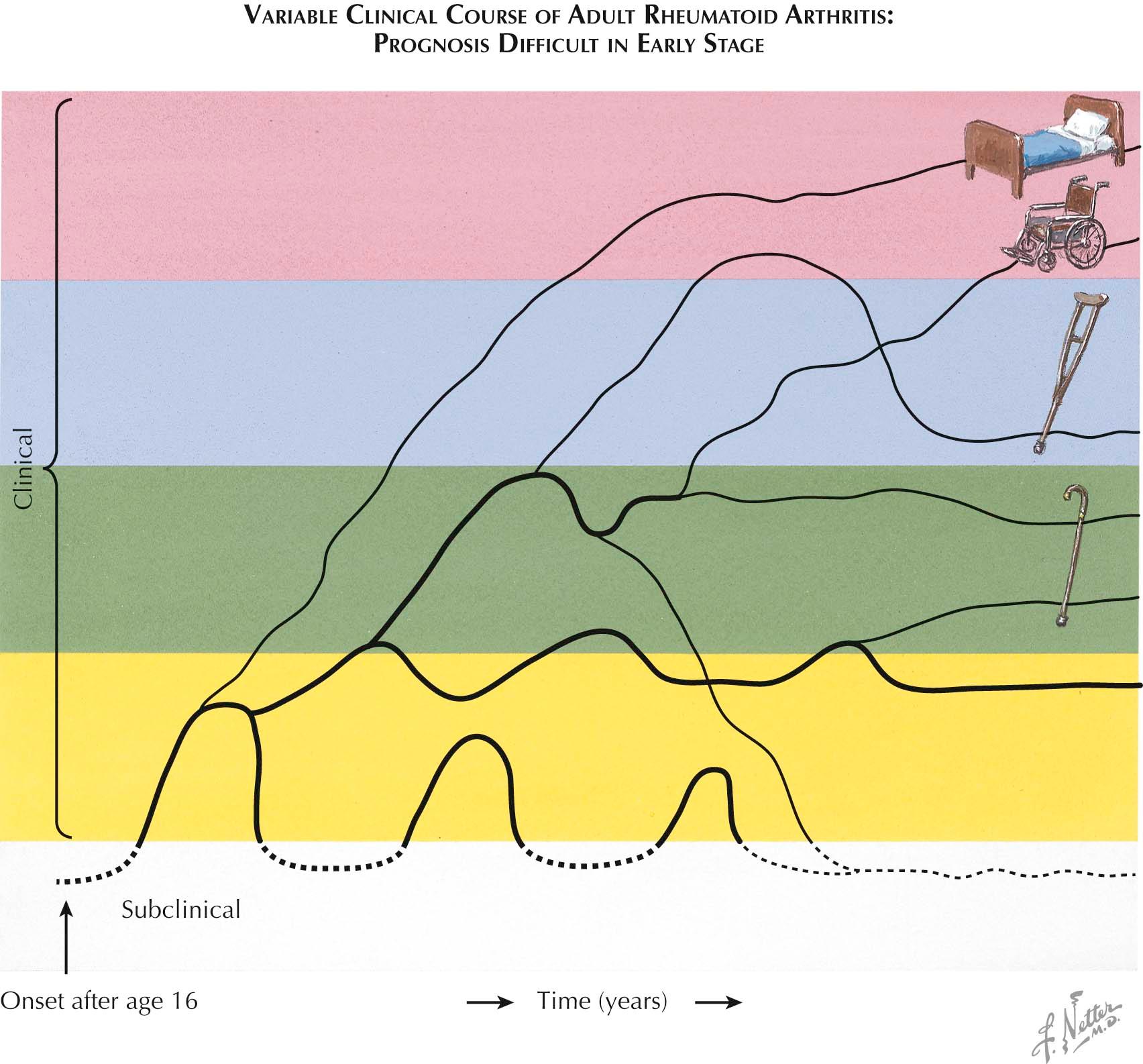
Early and prolonged remission is more likely if the disease is mild at onset. Although partial or even complete remission may occur at any time and continue for a long time, complete remission is seldom seen after 3 or 4 years of continuously active disease.
Appropriate therapy can slow down or arrest the disease process, can relieve joint pain, allows patients to be more active, and helps to avoid disability and incapacitation. Before the early 1990s, it was true that the amount of joint damage and disability was greater after 10 years of continuously active disease than after 5 years and was greater still after 15 years. Thanks to the introduction of newer therapeutic agents, particularly biologic agents since 1998, the frequency of joint damage has been significantly reduced and joint deformities have become less prevalent, as has the need for joint replacement surgery.
Early in the course of the disease, when synovitis and mild systemic illness are the only clinical manifestations, it is often very difficult to distinguish rheumatoid arthritis from other rheumatic diseases. Because there is no reliable laboratory test for rheumatoid arthritis, diagnosis depends on the judgment of a well-informed physician, usually based on frequent physical examinations and laboratory studies performed over many months. The most significant diagnostic findings are synovitis in many joints (especially paired joints in the limbs); systemic signs and symptoms; elevated ESR; circulating rheumatoid factor in serum; and rheumatoid nodules. However, circulating rheumatoid factor may not be detected for many months after the onset of illness, and many patients remain seronegative. Likewise, radiographic changes become visible only after months of persistent joint inflammation.
Diagnosis is not difficult after the illness has become chronic or when any of the following manifestations are present: rheumatoid nodules; rheumatoid factor in serum; characteristic joint deformities; and radiographic evidence of articular cartilage thinning, subchondral bone destruction, joint deformity, or ankylosis.
Criteria. The following criteria, formulated by the American Rheumatism Association (ACR) in 1987, are a reliable basis for accurate diagnosis:
Morning stiffness
Arthritis of three or more joint areas
Arthritis of hand joints
Symmetric arthritis
Rheumatoid nodules
Serum rheumatoid factor
Radiographic changes
A patient could be classified as having rheumatoid arthritis if at least four of these criteria were satisfied; four of the criteria must have been present for at least 6 weeks. In 2010, ACR/EULAR (European League Against Rheumatism) classification criteria were introduced to make a diagnosis of early rheumatoid arthritis among patients newly presenting with undifferentiated inflammatory synovitis. The differential diagnoses includes many other inflammatory conditions.
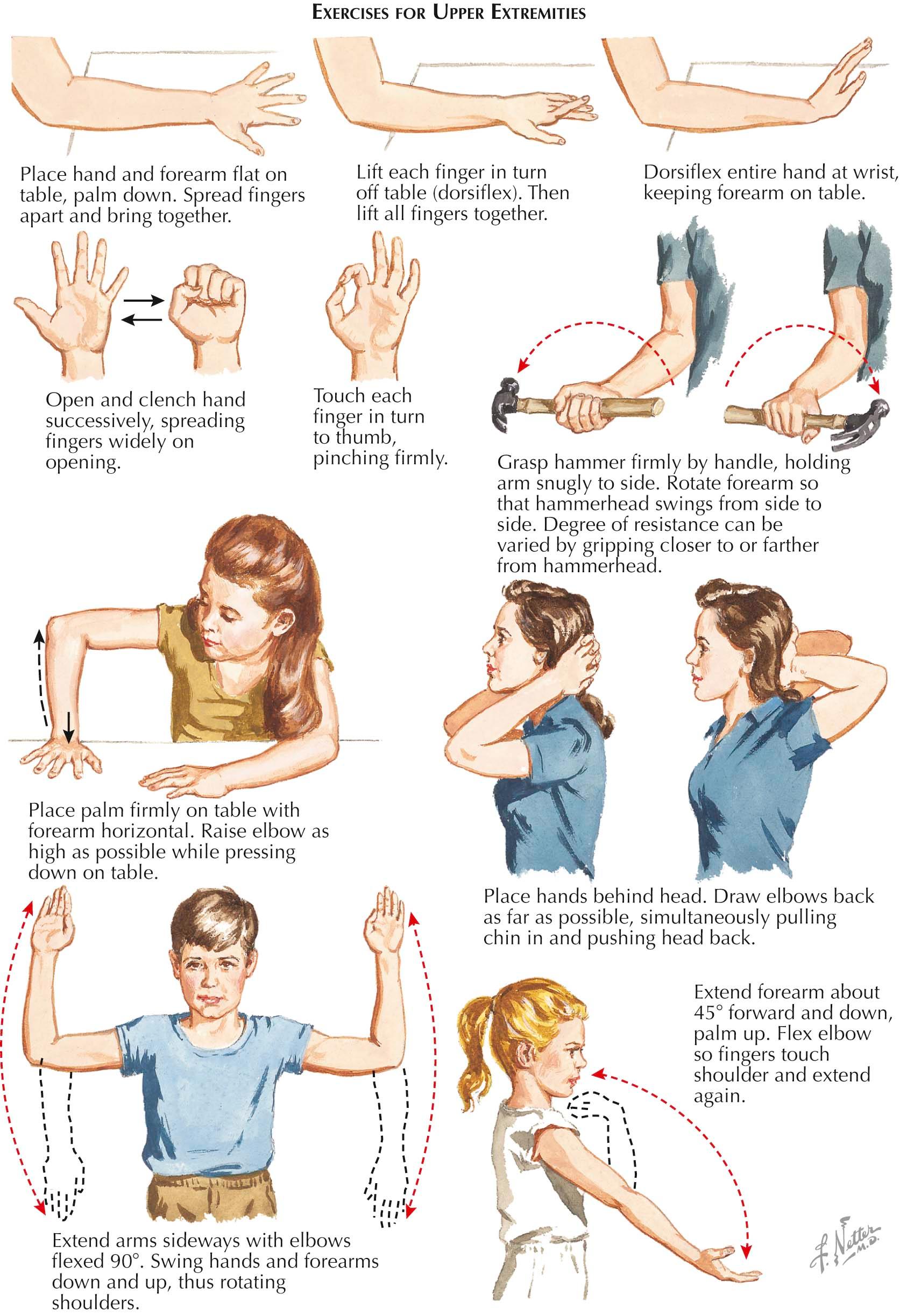
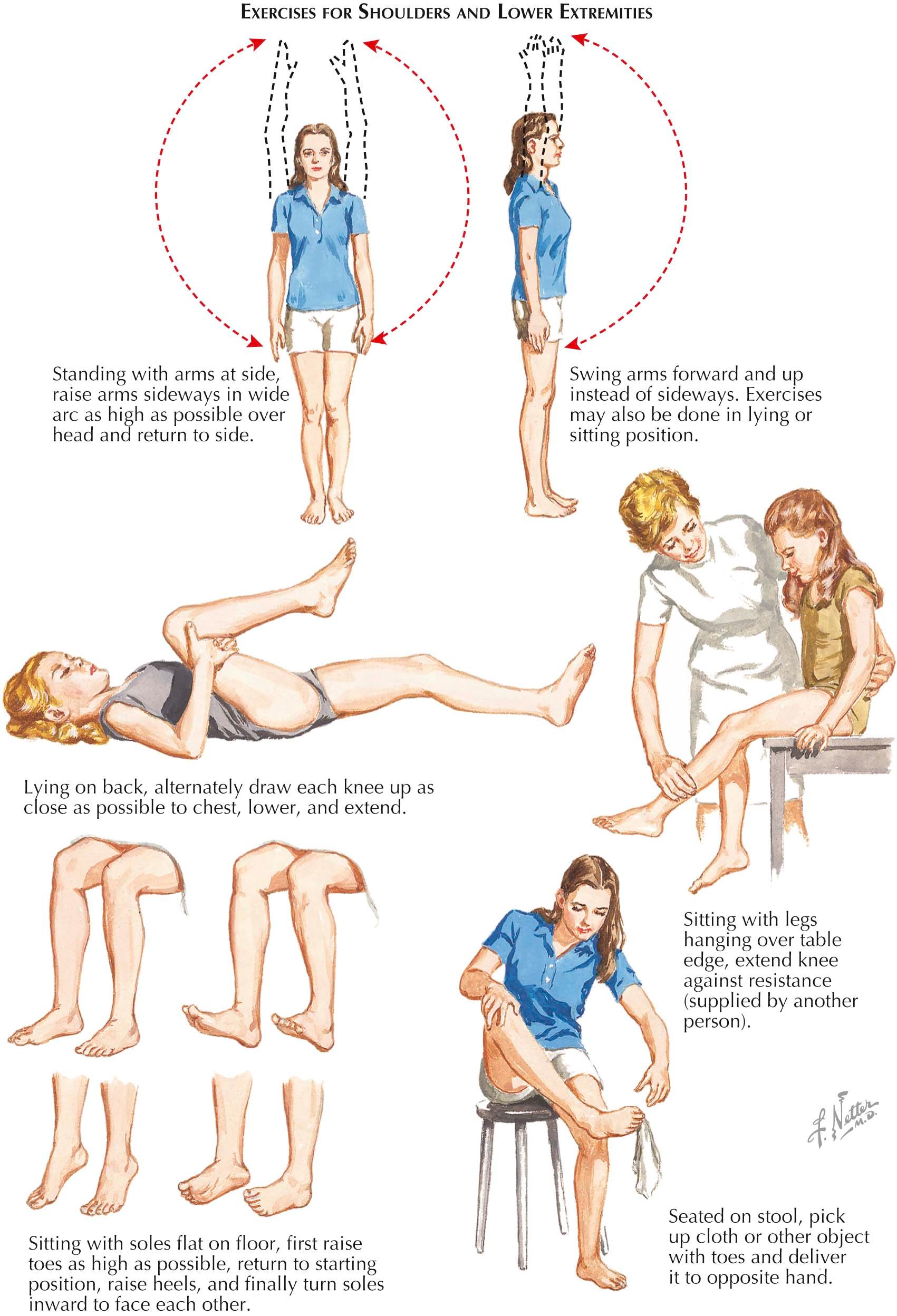
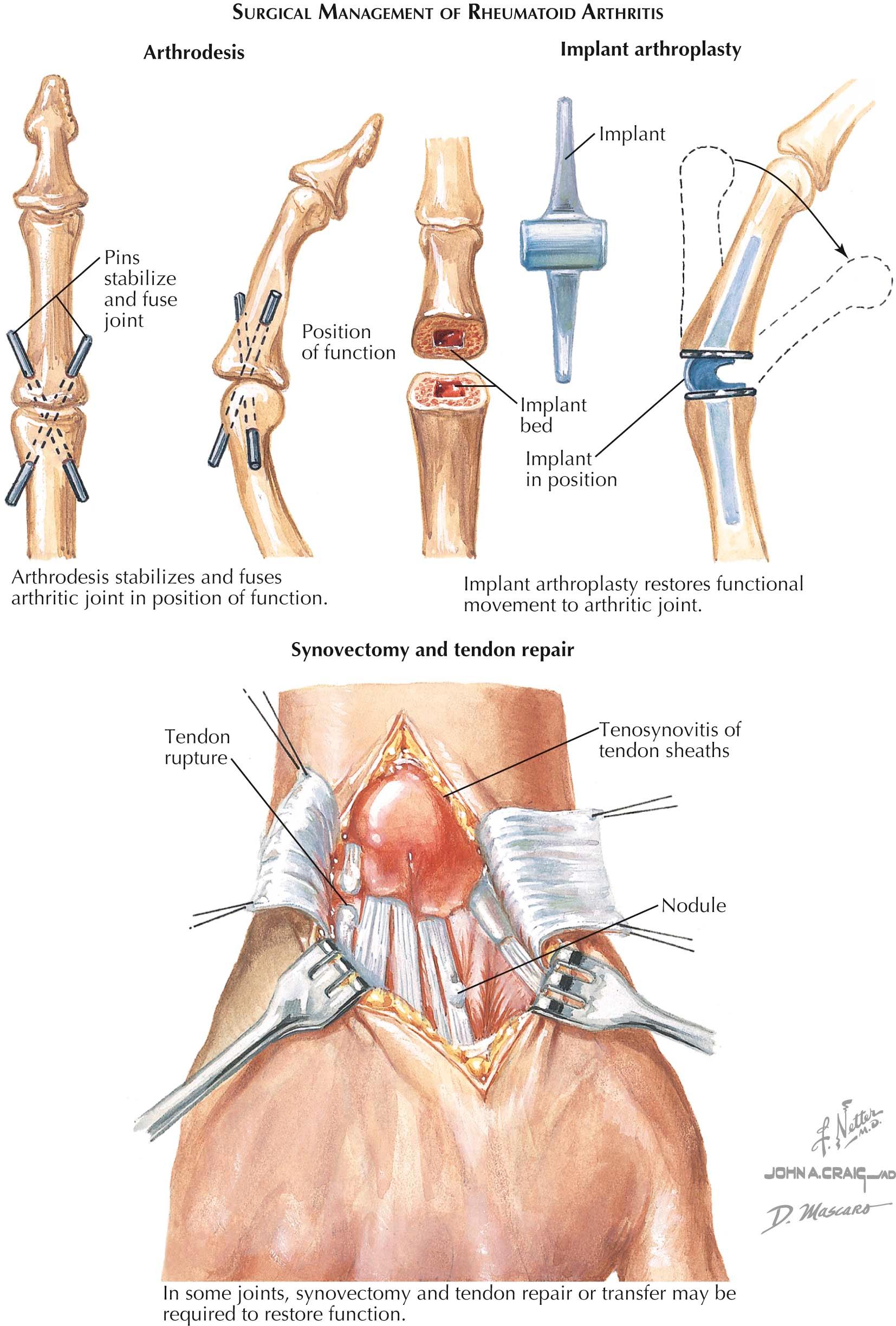
Rheumatoid arthritis is a heterogeneous disease, and there is recognition that treatments will vary among individuals. Early consultation with a rheumatologist is advised to confirm the diagnosis and to outline a treatment plan with the patient. Factors that will influence the therapeutic options include the disease's duration, prognosis, severity, and activity. The simplified goals of therapy, however, remain the same among all patients.
These goals include:
Education of the patient
Relief of pain
Preservation and restoration of function
Modification of disease progression and damage
With the acquired understanding of the early onset of damage and the ultimate impact on the debility and disability of the rheumatoid arthritis patient, the algorithms of treatment have changed focus to a more aggressive and early approach. The concept of treating to a target of remission or low disease activity state is now widely accepted.
The physician will need to enter into a treatment partnership with the rheumatoid arthritis patient. The education of the patient as to his or her disease features, course, prognoses, and medication adverse effects is the key to a successful treatment program.
Exercise with stretching and strengthening of the involved joints is beneficial in the majority of cases, and patients should be encouraged to stay active (see Plates 5-10 and 5-11 ). Patients may benefit from a consultation with an occupational and/or physical therapist to help guide and outline an exercise plan. Rest and/or splinting of an acutely inflamed joint may be necessary in some cases. Bed rest and hospitalization is rarely needed in the present era.
Rheumatoid arthritis patients should be encouraged to eat a healthy and balanced diet. Overweight patients should be encouraged to lose weight because excess weight placed on inflamed joints may hasten the damage. There are very little data to support a specific diet in rheumatoid arthritis. An exception may be the increase in dietary or supplemental fish oils, which may provide an anti-inflammatory effect.
Many patients are curious about alternative and complementary pathways of treatments. Unfortunately, there are little data to support the efficacy or ensure the safety of these therapies.
The rheumatoid arthritis patient should be encouraged to discontinue tobacco use because there are good data to support the poor prognostic implications of smoking.
Rheumatoid arthritis and other inflammatory and autoimmune diseases appear to be independent risk factors for cardiovascular disease. In addition to cessation of smoking, the individual patient should be assessed for other cardiovascular risk factors, and these should be modified as deemed indicated.
Decreased bone mineral density is common in rheumatoid arthritis patients. Other risk factors including postmenopausal state and corticosteroid use may contribute. Patients should be assessed by bone densitometry testing, and then treatment directed toward bone health should be rendered as indicated.
As a general rule, it is recommended that patients have updated all of their age-appropriate malignancy screens and vaccinations. Some vaccinations may be less effective or contraindicated while certain immunosuppressive medications are being used.
Pharmacologic treatment for rheumatoid arthritis is divided into five categories:
Analgesics
Nonsteroidal anti-inflammatory drugs (NSAIDs)
Corticosteroids
Nonbiologic disease-modifying antirheumatic drugs (DMARDs)
Biologic DMARDs
As outlined previously, aggressive and early treatment regimens are now the standard of care for rheumatoid arthritis, and most patients will warrant being started on one or more DMARDs at their initial diagnosis. All other medications, including analgesics, NSAIDs, and corticosteroids, are considered adjunctive or bridge therapies. The treatment options will be initiated and further adjusted based on the patient's disease duration, prognosis, severity and activity. Both the ACR (in 2008) and EULAR (in 2010) have put forth recommendations for the pharmacologic management of patients with rheumatoid arthritis. The goal of such treatment is to have the patient reach a state of low disease activity or preferably remission.
Analgesics. Pain is the typical chief complaint of the rheumatoid arthritis patient. In spite of aggressive DMARD treatment, many patients will require adjunctive treatment for pain. NSAIDs may fill this role, but for many patients these drugs may be contraindicated or inadequate. Topical agents, such as capsaicin or diclofenac, may be successful. Examples of oral agents include acetaminophen, tramadol, and more potent opioids.
Nonsteroidal Anti-inflammatory Drugs (NSAIDs). NSAIDs interfere with the production of prostaglandins and thus are effective in the reduction of inflammation and, therefore, pain. Many patients will require these agents along with DMARDs for pain management, but NSAIDs should be considered adjunctive and not be used alone for rheumatoid arthritis. There are no data to support NSAIDs as DMARDs. They can also be helpful as a bridge therapy while DMARDs are being initiated. Gastrointestinal adverse effects, including peptic ulcer disease and gastrointestinal bleeding, are the most common reason for discontinuation of these agents. These drugs will be contraindicated or receive limited use in those patients with backgrounds of gastrointestinal bleeding and chronic kidney and liver disease. Cyclooxygenase (COX)-selective NSAIDs (celecoxib) have the advantage of decreased gastrointestinal toxicity, but there remains concern about increased cardiovascular risk in this class compared with the nonselective NSAIDs.
Corticosteroids. As with NSAIDs, systemic corticosteroids can be a beneficial adjunct or bridge therapy (when starting a DMARD) in patients with rheumatoid arthritis. These drugs are very effective in reducing inflammation and, likewise, the signs and symptoms of the disease. Their side effects, including weight gain, cataracts, hypertension, diabetes, infection, and osteoporosis, typically limit their more long-term use; however, some patients may require longer-term use with lower dosages to retain joint function. Intra-articular corticosteroids can be useful when one or two joints remain inflamed in the presence of DMARD therapy or during a flare of the arthritis.
Nonbiologic Disease Modifying Anti-Rheumatic Drugs (DMARDs). DMARD therapy is the cornerstone of the treatment of rheumatoid arthritis. These drugs inhibit inflammatory responses, suppress synovitis, and, in studies, have been shown to improve the signs and symptoms of rheumatoid arthritis and to slow the natural progression of the joint damage. Unless contraindicated or refused, all patients should be started on a DMARD at diagnosis. Patients may not respond to DMARD therapy for up to 3 months after a therapeutic dose is achieved. The evaluation of efficacy requires frequent monitoring of disease activity.
The most common DMARDs are:
Methotrexate
Leflunomide
Sulfasalazine
Hydroxychloroquine
Methotrexate has become the most commonly used member of this group. It is given either orally or subcutaneously at dosages of 7.5 to 25 mg a week. Common side effects include rash, oral ulcers, nausea, and hair loss. More serious side effects including significant cytopenias, cirrhosis, and pulmonary fibrosis are quite rare with these low dosages and close monitoring. Methotrexate is contraindicated in patients with chronic kidney and liver disease, with moderate alcohol use, in pregnancy, and in women and men actively attempting conception.
Leflunomide is given orally at 10 to 20 mg/day. Common side effects include rash, diarrhea, and alopecia. Elevated liver transaminase levels and cytopenias can be observed. This drug is also contraindicated in pregnancy and in women and men actively attempting conception.
Sulfasalazine is given orally at divided dosages from 1000 to 3000 mg a day, typically starting at lower dosages. This drug is rarely used alone in a patient with a poor prognosis or high disease activity. Adverse effects include abdominal pain, diarrhea, nausea, rash, and, rarely, cytopenias and renal or hepatic dysfunction.
Hydroxychloroquine is likewise recommended for patients with better prognosis and less severe disease. Typical dosages are in the range of 200 to 400 mg/day. It is the best tolerated of all of the DMARDs and rarely will cause rash or gastrointestinal upset. The well-described retinal toxicity is extremely rare when used at dosages of less than 6 mg/kg/day. Routine eye examinations (tangent screen) are required and can detect early toxicity, which is reversible on discontinuation.
Biologic Disease-Modifying Anti-Rheumatic Drugs. Biologic DMARDs target certain pathways in cell signaling that lead to the inflammatory responses. In the current algorithms, these biologic agents are traditionally reserved for those patients who have not had an adequate response (either remission or low disease activity state) with a nonbiologic DMARD. However, as of this writing, there is a growing movement to consider starting biologic agents at the initial diagnosis, either alone or in combination with nonbiologic DMARDs. In studies, these drugs have been shown to decrease symptoms, improve function, and slow radiographic progression of rheumatoid arthritis.
The first agents in this category were inhibitors of TNF-α (anti–TNF-α agents). Currently, five of these drugs have been approved by the U.S. Food and Drug Administration:
Adalimumab (fully human monoclonal antibody)
Certolizumab (pegylated humanized Fab′ fragment of TNF monoclonal Ab)
Etanercept (fusion protein: TNF receptor attached to the Fc region of human IgG)
Golimumab (fully human monoclonal antibody)
Infliximab (chimeric monoclonal antibody)
Anti–TNF-α drugs are usually the first biologic agent used in patients with rheumatoid arthritis. These agents are subcutaneous injections, except infliximab, which is an intravenous preparation. The side effects are similar among all and include injection or infusion reactions, infections, and, rarely, demyelinating diseases and malignancies. Patients need to be screened for latent infections, including tuberculosis, before treatment.
Anakinra, an IL-1 inhibitor, is available but has lost favor over time. It is injected subcutaneously daily. It has not shown as robust of a response as other biologic agents in treating rheumatoid arthritis.
Abatacept is a fusion protein of CTLA4-Ig and blocks T-cell co-stimulation. The drug is delivered intravenously once a month. Side effects have included infusion reactions and infections.
Rituximab depletes B lymphocytes as a monoclonal antibody against CD20. It is also given intravenously in two infusions separated by 2 weeks. Treatments may be repeated at 6-month intervals. Infusion reactions and infections remain the most significant risks.
Tocilizumab is an IL-6 receptor antagonist given intravenously every 4 weeks. Risks have included infusion reaction, infections, and elevated liver transaminase levels.
Combinations of DMARDs. Controversy exists on the proper use of combination DMARD therapy. Strategies have included the following:
Sequential monotherapy
Initial combination therapy
Step-up combination therapy
Step-down combination therapy
Nonbiologic DMARDs can be combined together. The combination of methotrexate and leflunomide carries the increased risks of hepatic and hematologic toxicity. In patients who have had an inadequate response to methotrexate, a biologic agent (most commonly an anti–TNF-α drug) is commonly added. Most agree that biologic DMARD agents should not be combined, owing to the increased infectious risks.
The benefits of surgical approaches to rheumatoid arthritis are pain relief and restoration of function. Surgical options include synovectomy, arthroplasty, and arthrodesis (see Plate 5-12 ). Synovectomy of joint and/or tendons is available for almost all joints. Arthroplasty is a well-accepted treatment strategy for arthritis of the hands, shoulders, and especially the hips and knees. However, advances in elbow, wrist, and ankle joint arthroplasty are also being made. Arthrodesis, or joint fusion, can be helpful for intractable disease of the fingers, wrists, toes, or ankles. Although surgical options are typically postponed for medical therapies, one should not ignore the pain relief and functional benefits afforded the appropriate patient by these techniques. Technologic advancements in the field of orthopaedics will improve surgical outcomes and replacement longevity.
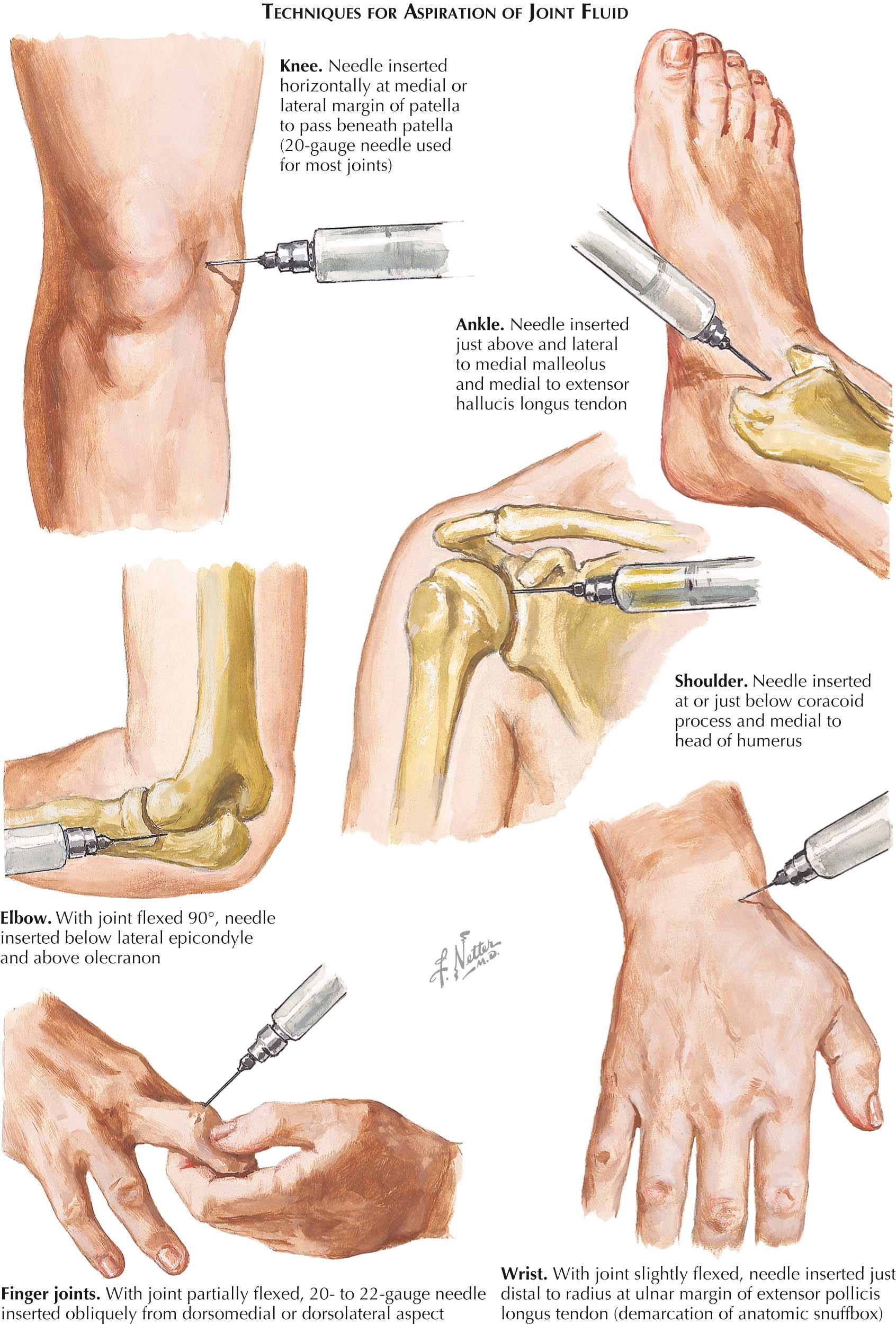
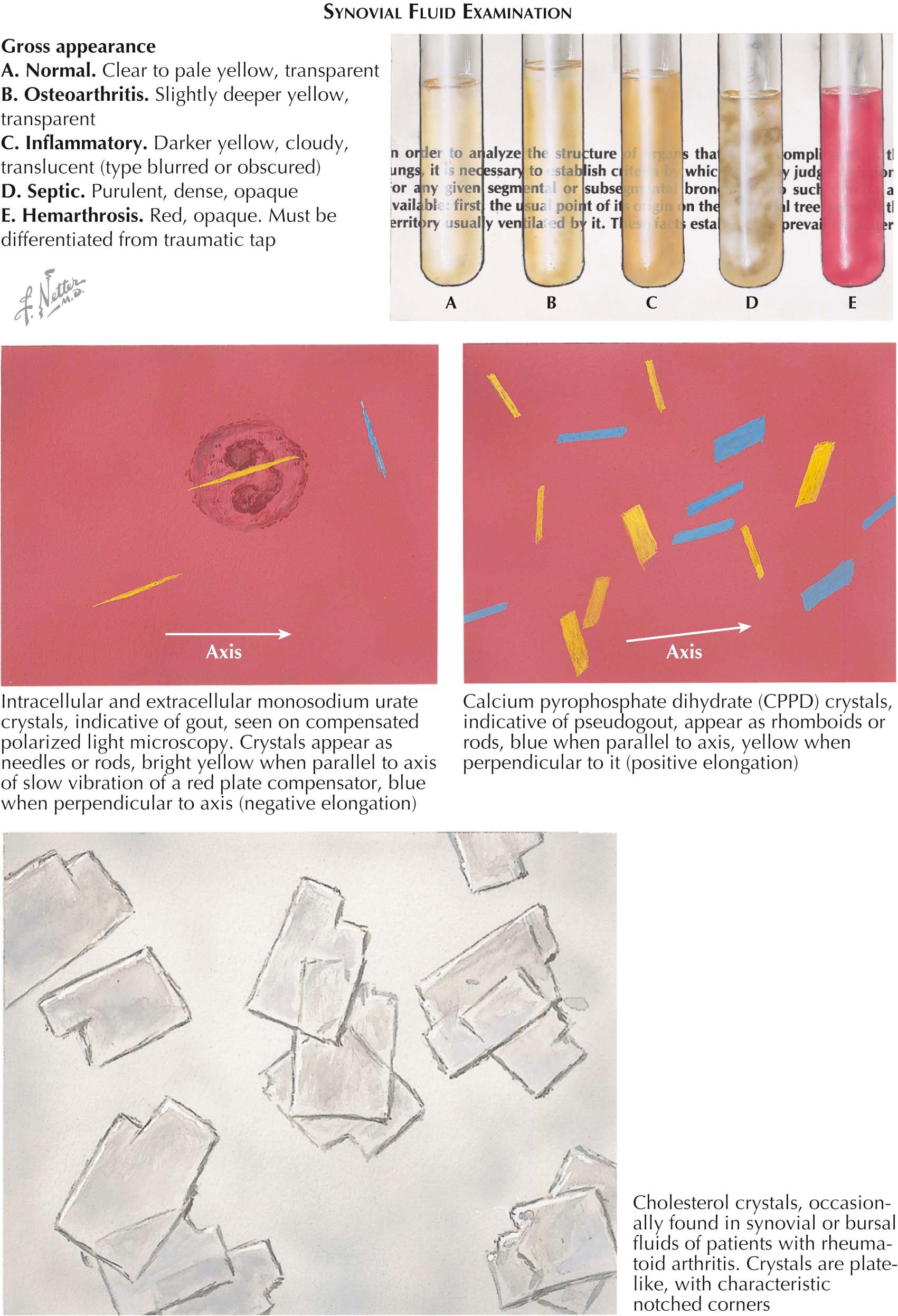
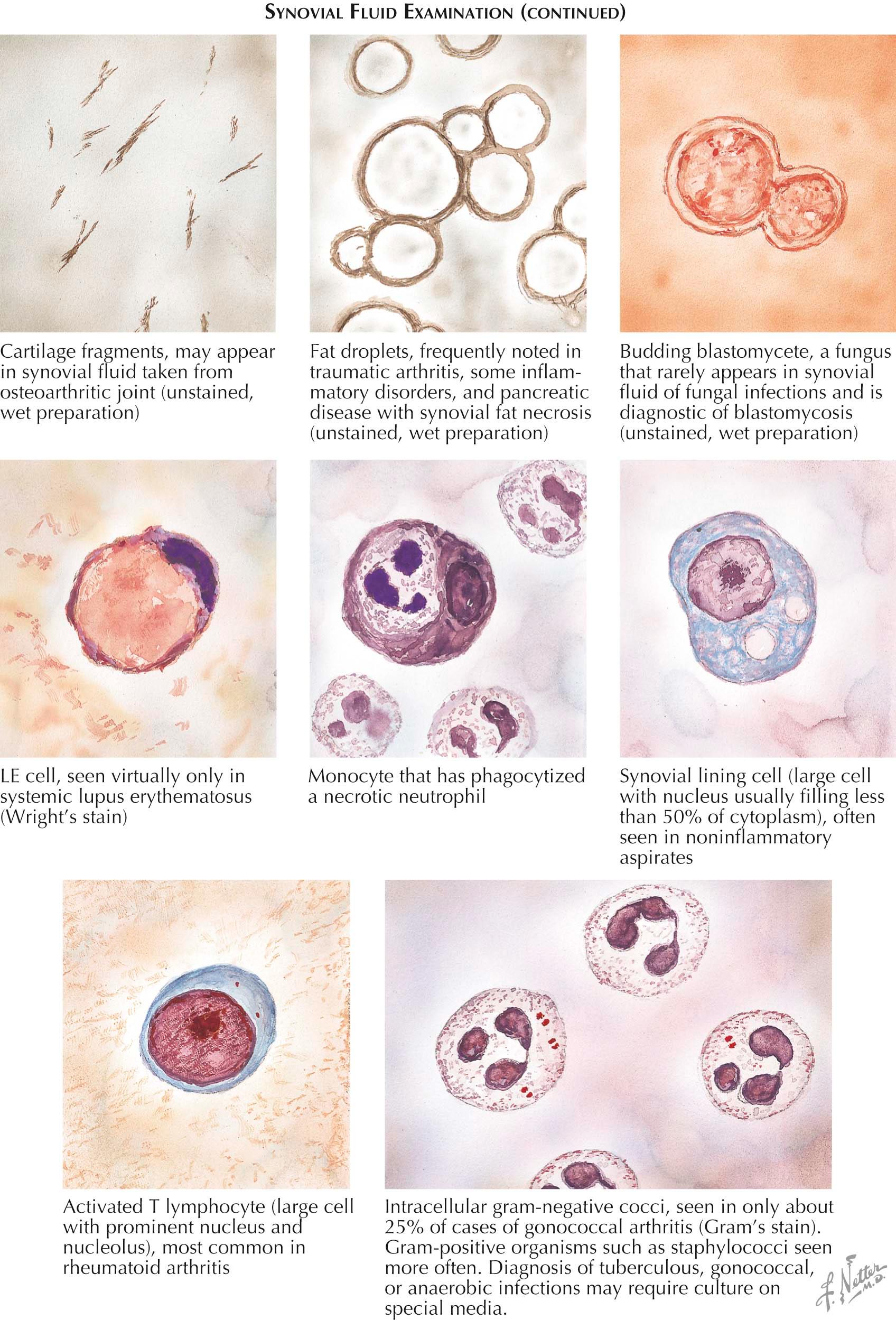
Synovial fluid analysis is necessary for the definitive diagnosis of acute crystal-associated and infectious arthritis. Analysis of joint fluid for culture, cell count and differential, and the presence of crystals is also useful in the evaluation of patients with chronic, unexplained inflammatory arthropathy. In a study of 180 consecutive patients with knee effusions, 20% of the initial diagnoses suggested by clinical signs and history were changed after analysis of joint fluid.
Although arthrocentesis can be performed by experienced clinicians using clinical landmarks, aspiration and injection of deeper joints (hip), complicated joints (wrist), and even large joints such as the knee and shoulder can be performed with far greater accuracy utilizing ultrasound guidance. Some joint aspirations are shown on Plate 5-13 . The knee is probably easiest to aspirate because simply positioning the needle beneath the patella suggests that it has penetrated the joint, but this is not ensured without fluid return or visualization of the needle position using ultrasound or alternative imaging.
The joint aspirated should be one that is symptomatic and swollen. The area is cleaned, and the site for needle puncture marked on the skin; this can be done with the wooden tip of a cotton swab. The skin and deeper tissue is infiltrated with a solution of 1% lidocaine for anesthesia. The aspiration needle should be at of least 20 gauge (22-gauge needles may be needed for finger or toe joints) to avoid plugging of the orifice with fat or other soft tissue.
Universal safety precautions should be practiced. One hand is used to identify the anatomic landmarks, with care not to touch the actual site. The initial thrust should be decisive; if fluid is not readily obtained, the position of the needle can be readjusted a little without withdrawing it. A small amount of fluid can be obtained from almost any joint. Only 1 mL of fluid is required for a thorough synovial fluid analysis, but more fluid may be removed, if needed, to relieve symptoms in a distended joint. Even a drop of fluid in the hub of the aspirating needle can allow identification of crystals or infectious agents (if seen on Gram stain), and an estimate of the white blood cell count.
The same procedure is used for intra-articular injections of depot corticosteroids. This treatment may provide temporary relief for some patients with osteoarthritis and more marked relief in patients with crystal-associated and other inflammatory arthritis. Synovial fluid should always be examined as part of the injection procedure and injection avoided if there is any suspicion of joint infection.
Based on the clinical signs and the symptoms reported by the patient, the specific tests and stains needed are determined before aspiration (see Plates 5-14 and 5-15 ). If infection is suspected, some fluid should be promptly delivered to the laboratory for culture.
Complications from joint aspiration/injection are extremely rare. To help avoid infection, the route of aspiration should not be through areas of cutaneous infection or a rash like psoriasis. Hemarthrosis resulting from a traumatic arthrocentesis (“bloody tap”) is a rare complication, and aspiration can be done even in patients being treated with anticoagulants. No special care is needed after the procedure, but rest for 1 to 2 days may increase the efficacy of injected corticosteroids.
Analysis of joint fluid begins with gross inspection. The fluid's appearance—clarity and presence of blood—may provide initial clues to the diagnosis and thus influence the physician's selection of laboratory tests.
The clarity of the fluid is assessed by experienced clinicians in the syringe but more reliably can be done by expressing a small amount of fluid out of the plastic syringe into a glass tube. (Plastic tubes have a slight opacity that may confuse the results; see Plate 5-14 ). Cloudy fluid is not typical of uncomplicated osteoarthritis and suggests an inflammatory process. An opaque, pasty fluid is most often due to pus, thus indicating the presence of infection, but a thick, purulent-appearing fluid occasionally results from massive numbers of crystals, amyloid, or, in rheumatoid arthritis, from degenerated synovial villi (rice bodies). Most infections do not produce pus; cloudy nonopaque fluids can also be due to infection.
Bloody fluid in the joint (hemarthrosis) suggests numerous diagnostic possibilities, including trauma (with or without fracture), pigmented villonodular synovitis, tumors in or near the joint, hemangioma, severe joint destruction (i.e., neuropathic), hemophilia, and, rarely, other bleeding disorders.
If joint infection is suspected, the aspirated fluid should be promptly transported to the microbiology laboratory. Some studies have suggested increased yield with the use of blood culture vials, but different laboratories have different collection guidelines. Unless there is specific clinical concern for mycobacterial, anaerobic, or fungal infection, it is appropriate and cost effective to send the initial fluid only for routine bacterial cultures. There is no purpose in sending the fluid for protein or glucose. Determination of lactate dehydrogenase in the fluid is not usually of value. Polymerase chain reaction may be beneficial when specific infections are suspected.
Crystal-induced arthritis is definitively diagnosed only from examination of joint fluid for the presence of intracellular or extracellular crystals (2 to 20 µm). Occasionally, crystals are also found in tissue or tophi. One or two drops of fluid are expressed onto a clean slide, which is promptly covered with a coverslip. Fluid on a slide can be preserved for a few hours, or a fresh drop preparation can be taken for each examination from fluid kept in a tube. The fluid should ideally be examined promptly because small numbers of calcium pyrophosphate dihydrate (CPPD) crystals may dissolve overnight and, with time, artifactual urate-like structures can form from degenerating cells; but this is not likely a common problem. Anticoagulants in collecting tubes are generally avoided because they may also produce confusing artifacts.
The fluid can be examined with a light microscope, and crystals can be reliably visualized by experienced observers; however, easier and more definitive identification is done utilizing a compensated polarized light microscope (see Plate 5-15 ). Urate crystals are usually shaped like needles; CPPD crystals are rods or rhomboids. The presence of depot corticosteroid crystals, even from an injection performed many days earlier, may confuse the diagnosis because they can appear similar to CPPD. Cholesterol crystals (i.e., plates with notched corners) are seen most frequently in chronic rheumatoid effusions and have an unclear role in joint inflammation.
The leukocyte count helps determine if the joint effusion reflects an inflammatory or noninflammatory process. Synovial fluid is usually heparinized before the cell count to reduce clumping.
Leukocyte counts greater than 2,000/mm 3 usually result in loss of transparency in the fluid, but confirmation that this is due to leukocytosis is important. A classification of joint effusions based on leukocyte counts has been developed. Counts over 75,000/mm 3 suggest the presence of infection, but very high counts (including those that are neutrophil predominant) can occur in psoriatic and crystal-induced arthritis and less commonly in rheumatoid arthritis.
Noninflammatory effusions usually contain three or fewer leukocytes per high-power field. Not all noninflammatory effusions are due to osteoarthritis. Some other causes include traumatic arthritis, acromegaly, hemochromatosis, hyperparathyroidism, ochronosis, Paget disease of bone, aseptic necrosis, amyloidosis, hypertrophic pulmonary osteoarthropathy, pancreatitis, and apatite-associated arthritis.
The wet preparations that had been examined for crystals can be used to provide a rough estimate of the leukocyte count. Other findings may also be noted (see Plate 5-15 ). For example, fat droplets, which usually indicate trauma, a result of marrow fat leaking into the synovial space, can also occur in pancreatic disease with synovial fat necrosis. Crystals of apatite deposition disease, seen in calcific tendonitis or in patients with Milwaukee shoulder/knee syndrome, create irregular, shiny, often nonbirefringent intracellular or extracellular chunks (of 2 to 20 µm) visible on wet preparations; individual crystals can be seen only on electron microscopy.
Single drops of joint fluid can be placed on a glass slide and smeared out into a thin preparation as for a blood smear. Air-drying preserves the cells for staining later in the day. If infection is being considered, smears should be stained with Gram's stain. Identification of pathologic organisms can guide the choice of initial antibiotic therapy, but failure to find bacteria on a Gram-stained preparation does not exclude infectious arthritis because positive stains for bacteria are uncommon, even with staphylococcal infection.
A differential count with more than 95% polymorphonuclear neutrophils is consistent with infection or crystal-induced disease (see Plates 5-14, 5-38 to 5-40 ) even if the leukocyte count is not very high. An inflamed joint space produces an ideal medium for the development of LE cells, which are seen almost exclusively in systemic lupus erythematosus (see Plate 5-51 ). Mononuclear cells that have phagocytized necrotic neutrophils may occur in reactive arthritis (see Plate 5-33 ), other seronegative spondyloarthropathies, or (occasionally) gout or pseudogout (see Plates 5-38 and 5-39 ). Large cells seen in blood smears include synovial lining cells, most common in noninflammatory disorders, and activated lymphocytes, which are common in rheumatoid arthritis and should not be confused with the rare tumor cell found in joints.
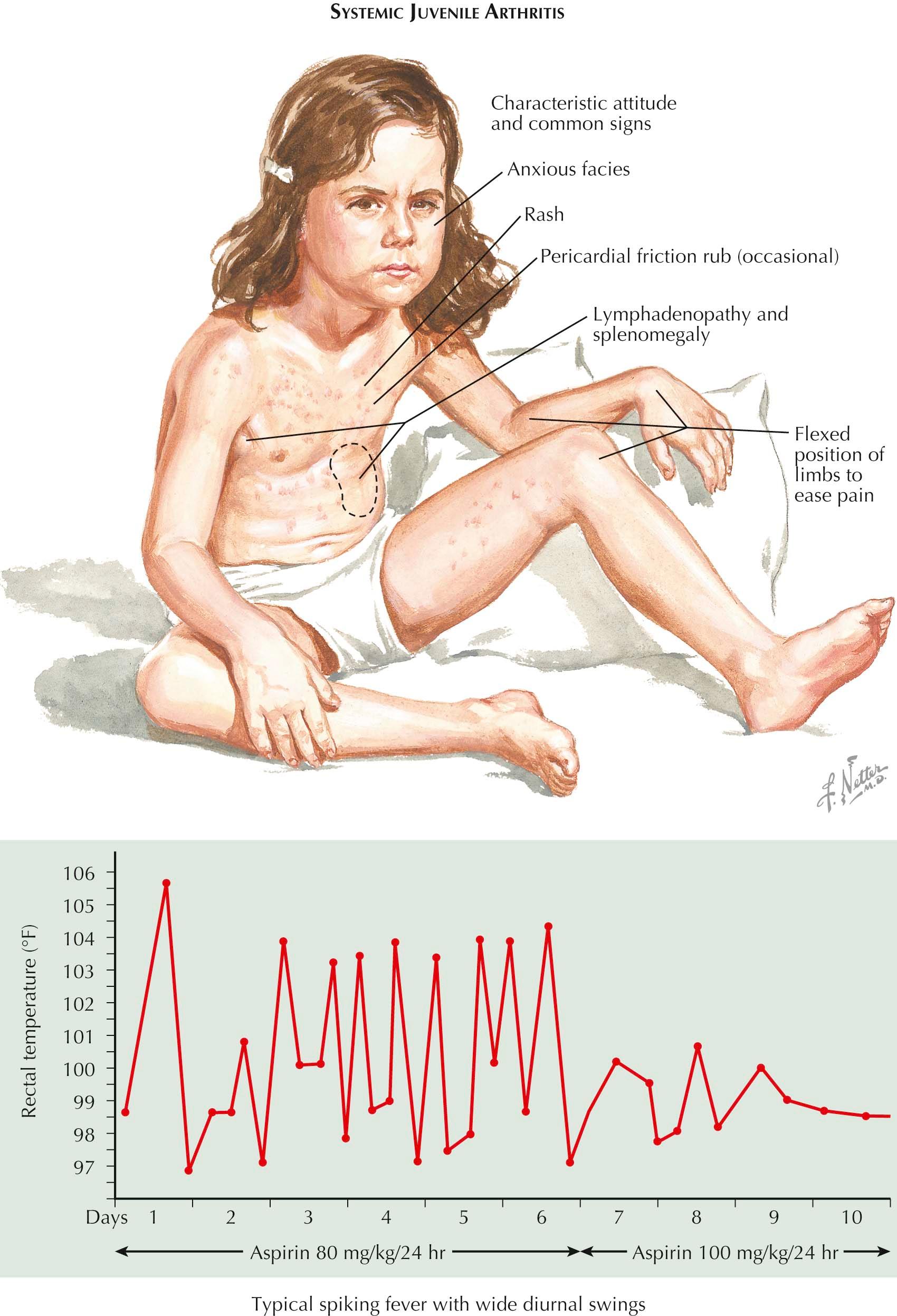
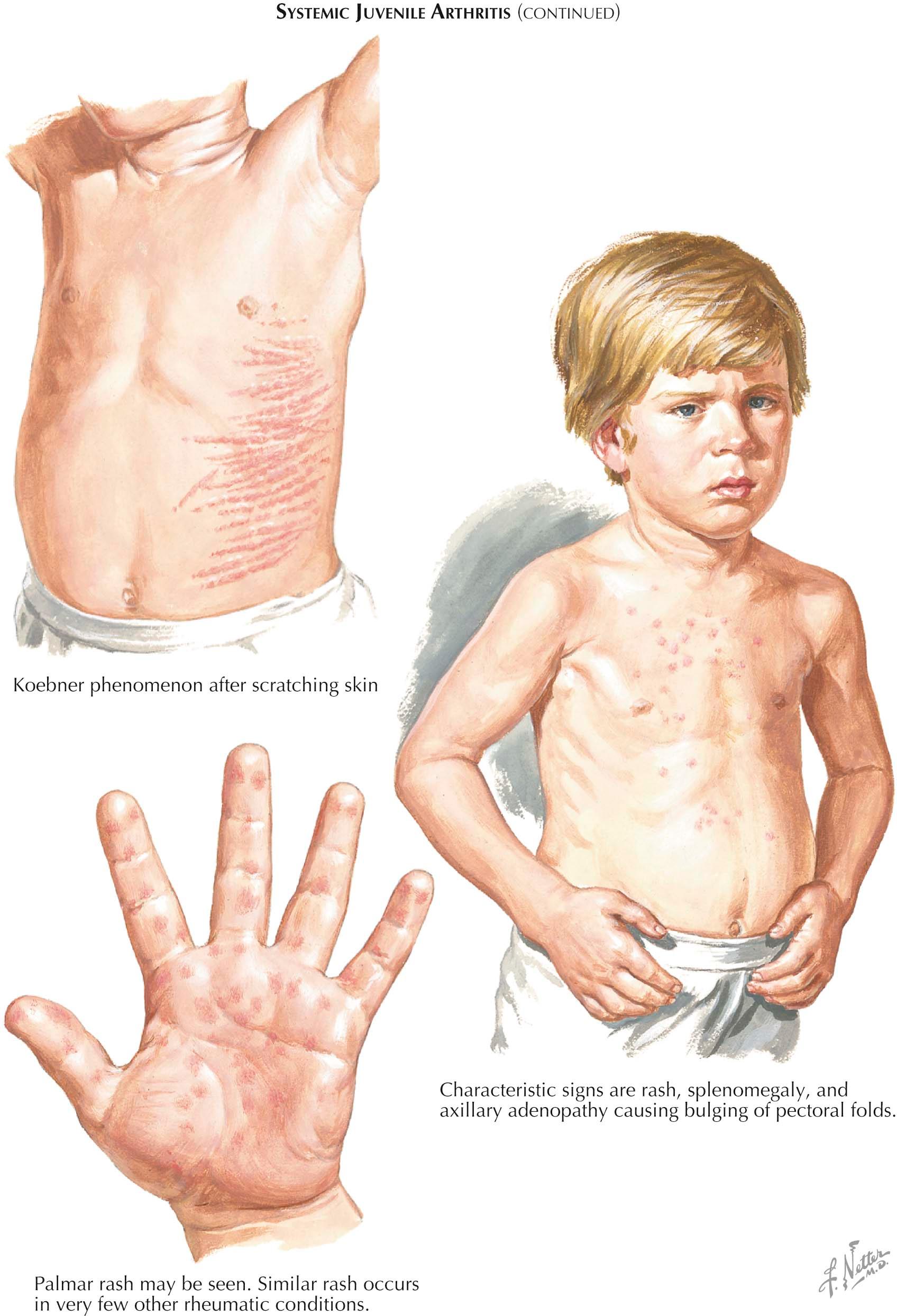
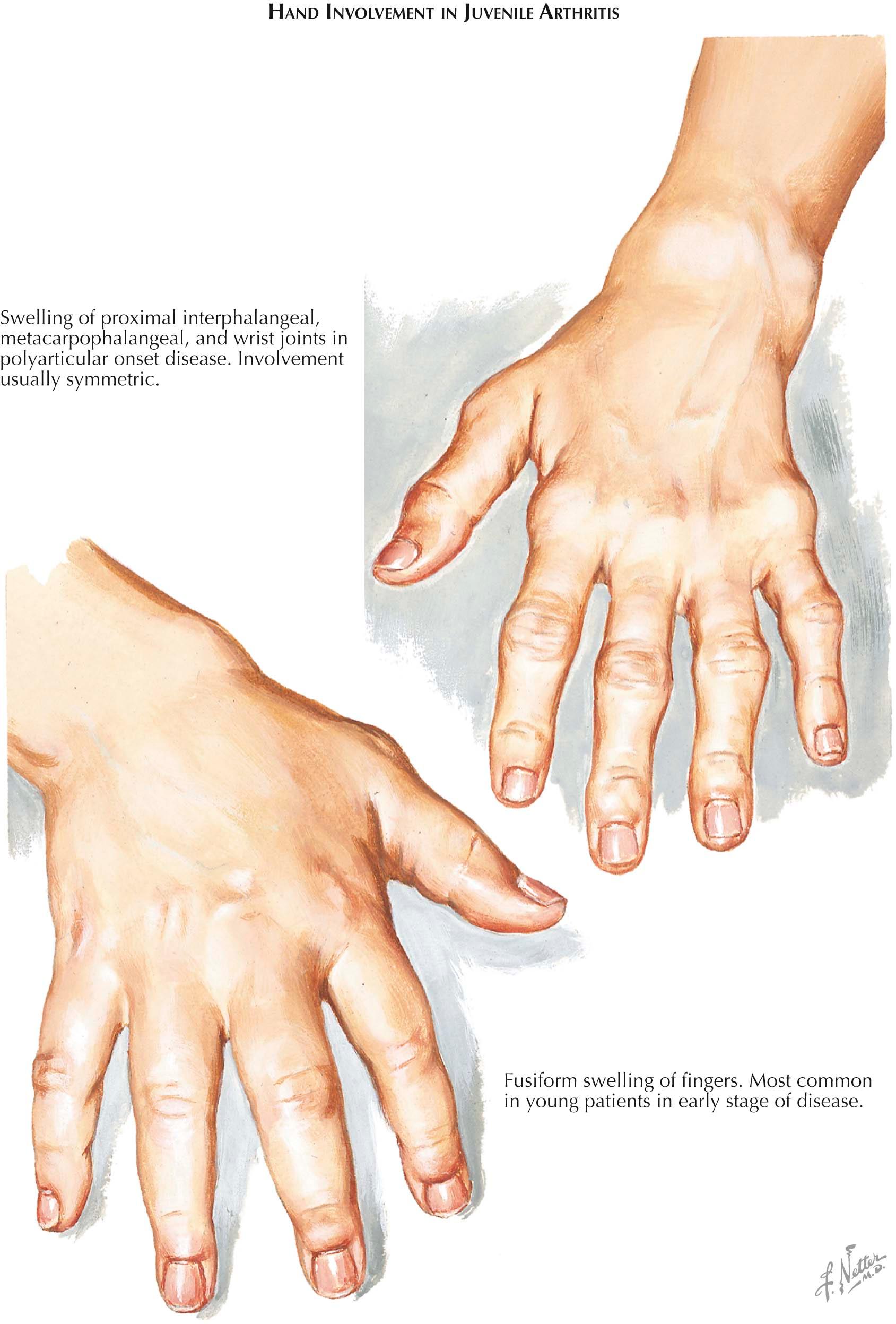
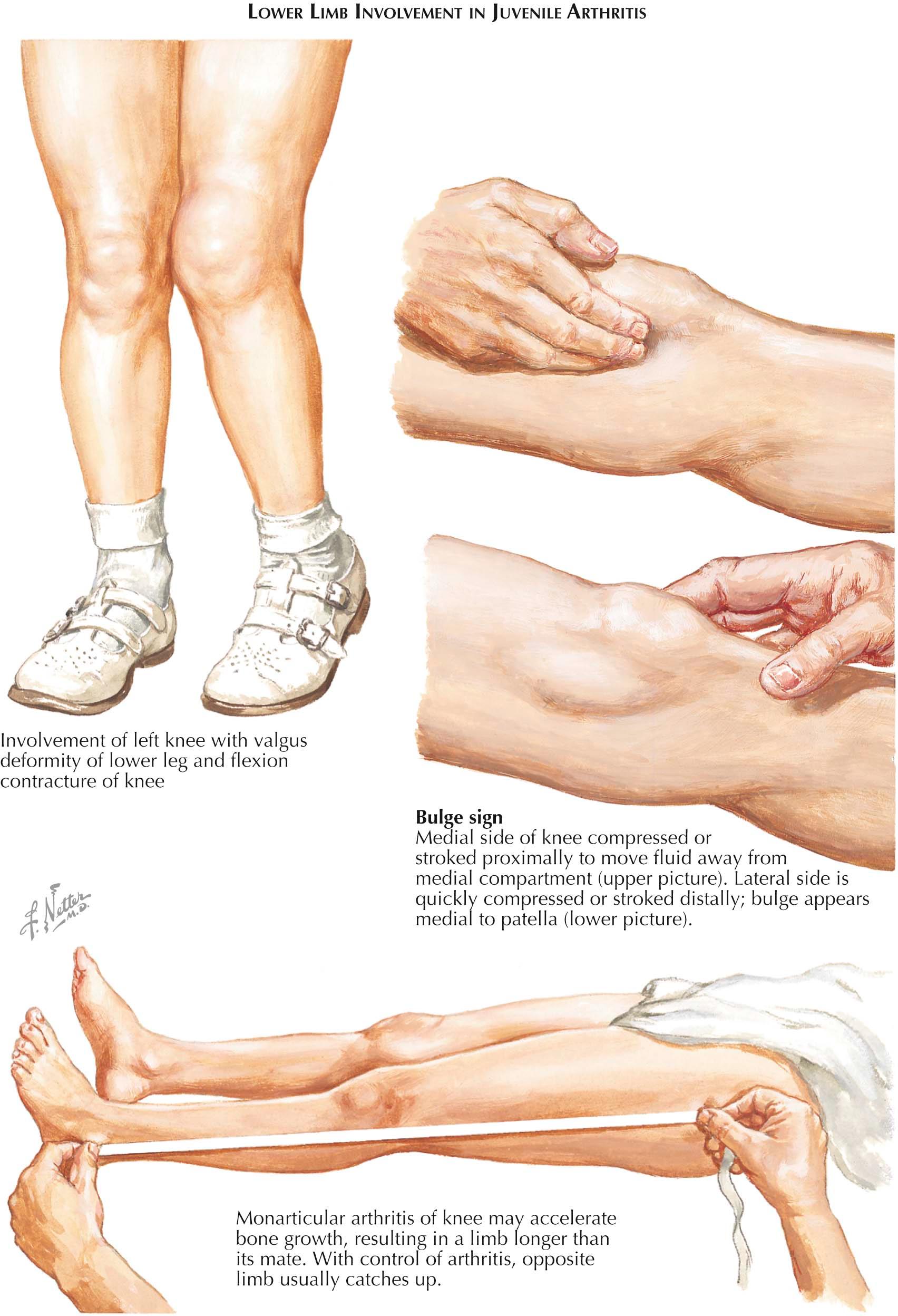
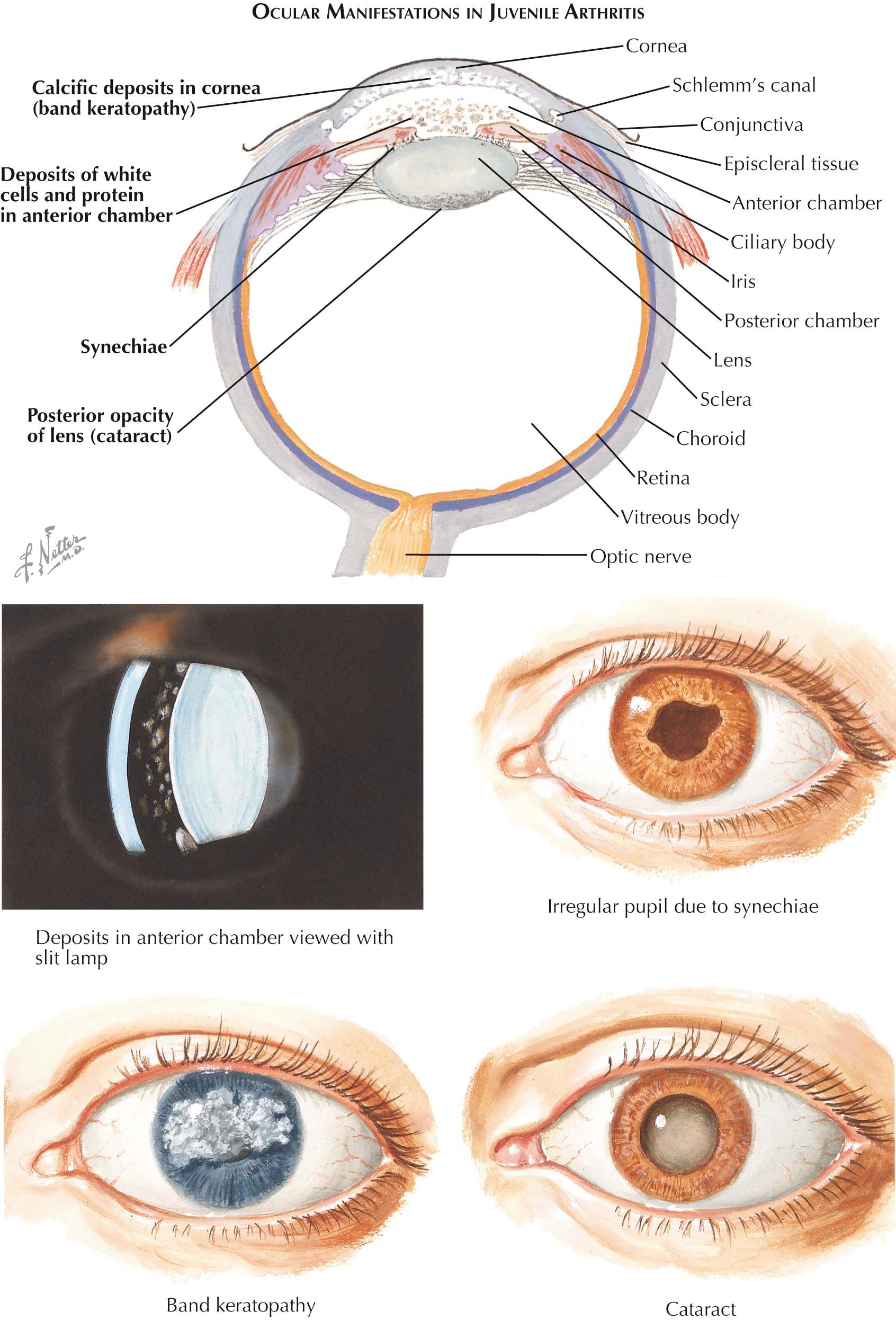
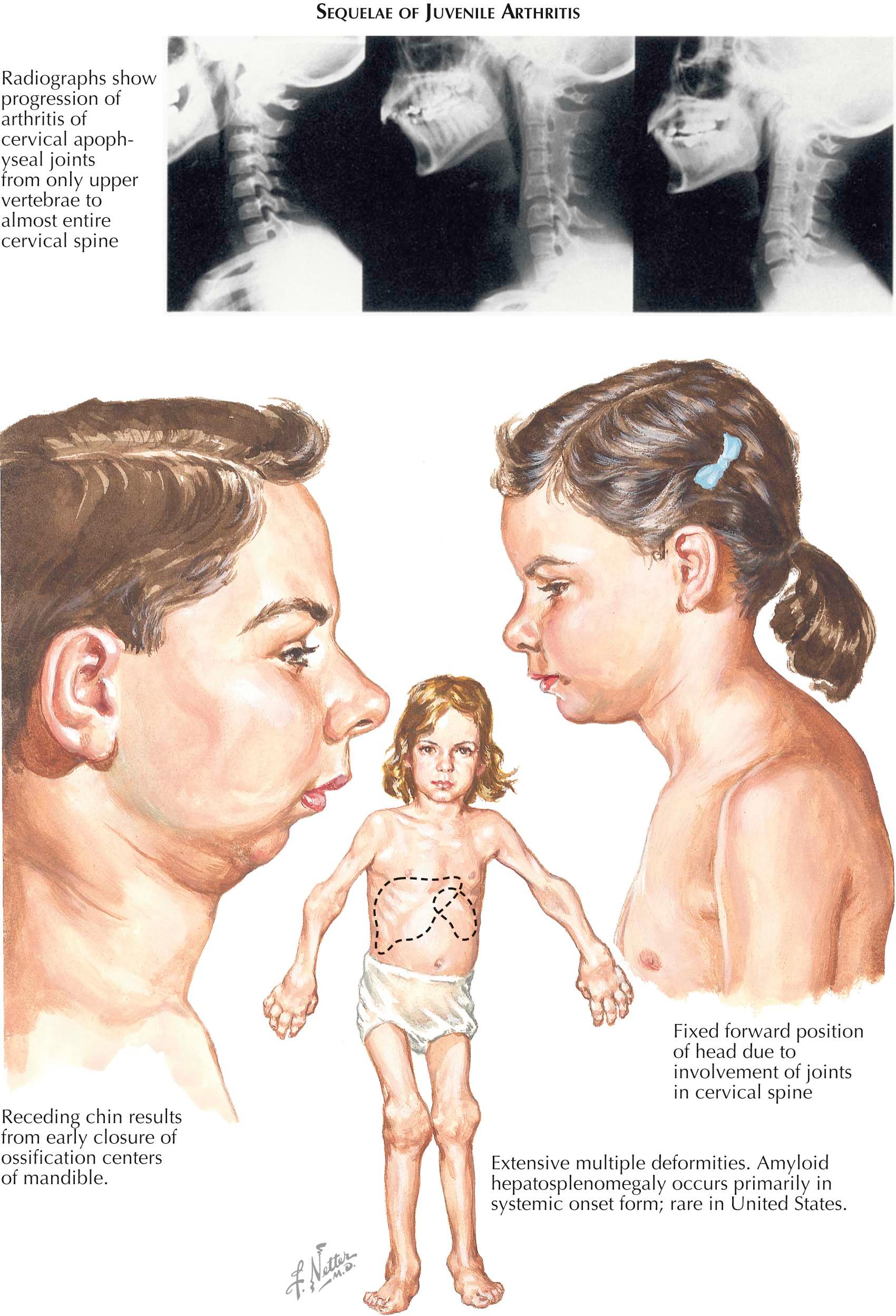
Because the clinical, laboratory, and genetic features of chronic arthritis in children differ significantly from those of classic adult rheumatoid arthritis, the term juvenile rheumatoid arthritis has been discarded in favor of juvenile idiopathic arthritis (JIA). The disease has a variable onset and course, making it impossible to develop diagnostic criteria that fit every case. The primary diagnostic criterion for JIA is arthritis in one or more joints that persists for at least 6 weeks in a patient younger than age 16 years after other possible causes have been excluded. In its simplest form, arthritis in children is a physical examination finding based on the observation of swelling within a joint, or limitation in the range of joint movement, joint pain with motion, or joint line tenderness. These findings should not be attributable to mechanical disorders or to other identifiable causes. Furthermore, other systemic manifestation in addition to arthritis may occur in children with JIA, including uveitis, psoriasis, inflammatory bowel disease, and serositis.
In 2004, major changes were made to the classification of children with JIA. Based on expert consensus, children with JIA were subclassified into seven subtypes: oligoarticular (either persistent or extended), rheumatoid factor–negative polyarticular, rheumatoid factor–positive polyarticular; systemic arthritis, enthesitis-related arthritis, psoriatic arthritis, and undifferentiated arthritis. Although these subcategories are useful in identifying populations for clinical trials, it is likely that they represent unique conditions that share arthritis as a cardinal feature.
Oligoarticular arthritis occurs in 55% to 60% of children with juvenile arthritis. The arthritis is limited to fewer than five joints during the first 6 months after diagnosis. Those patients whose arthritis remains confined to four or fewer joints 6 months after diagnosis are classified as having persistent oligoarticular JIA. Some children may develop involvement of five or more joints after the initial 6-month period and are classified as having extended oligoarticular JIA. In patients whose arthritis extends beyond a few joints, the disease resembles rheumatoid factor–negative polyarthritis and produces more dysfunction than was predicted from the original, limited involvement. Disease activity may be intermittent and even recur in previously uninvolved joints, even after years of remission.
Oligoarticular disease is most likely to be found in toddlers and in females more frequently than males. It is rare for these children to complain about pain; medical care is typically a result of parental observation of joint swelling or the onset of a new functional disability. The knee is most often affected in oligoarticular-onset disease, and monarticular involvement is common. When the knee is involved, parents will often report their child limps in the morning or wishes to be carried. The ankles are the next most common site of involvement, followed by the wrists, elbows, and hips. The small joints of the hands and feet, the cervical spine, and the jaw are affected less often than in polyarticular-onset arthritis.
In some children, the joint contains only a small amount of fluid, particularly in the early stages. The bulge sign is used to confirm the presence of small amounts of fluid in the knee (see Plate 5-19 ). The bulge is elicited by compressing or stroking proximally the medial side of the knee, moving fluid into the suprapatellar bursa and the lateral compartment. Rapid compression of the lateral compartment moves fluid back to the medial side, resulting in a bulging of the medial compartment. The effusion may also be demonstrated by compressing the suprapatellar bursa or by distally stroking the lateral compartment. Other important physical examination findings include muscle atrophy or joint contractures.
In monarticular disease, overgrowth of the involved limb may occur as a result of increased blood supply to the immature growth plate; this is seen most frequently with arthritis of one knee. With remission or treatment, overgrowth ceases, allowing growth in the uninvolved limb to catch up. If left untreated, persistent inflammation results in premature closure of the growth plate and shortening of the affected limb. If the limb-length discrepancy is predicted to be greater than 2.5 cm, early epiphyseal stapling or epiphysiodesis of the affected side may be indicated.
Uveitis in Juvenile Idiopathic Arthritis. A potentially blinding yet clinically silent uveitis is most likely to develop in children with oligoarticular JIA. Only 5% of children with the polyarticular subtype will develop uveitis compared with approximately 20% of children with oligoarticular JIA. This ocular inflammation usually begins within 2 years of the onset of arthritis, and nearly always within the first 4 years. In some children, uveitis becomes evident before the joint manifestations and it is typical for the inflammatory activity in the joints and eyes to occur independent of each other. Patients most at risk for uveitis are girls who are younger than 6 years of age at the onset of arthritis with the oligoarticular subtype, a positive antinuclear antibody (ANA) test, and disease duration of less than 4 years. Periodic slit lamp examination is used to detect ocular inflammation in the early stage and is mandatory in all children with juvenile arthritis. The early changes are not seen readily with the ophthalmoscope.
Uveal inflammation primarily affects the iris and ciliary body, and slit lamp examination reveals white cells and protein in the anterior chamber (see Plate 5-20 ). Fibrin strands may develop between the iris and the anterior surface of the lens (synechiae), resulting in a fixed or irregular pupil. White blood cells and protein deposited on the surface of the cornea may calcify, resulting in band keratopathy, which can obstruct vision. Cataracts may be caused by a combination of factors, including inflammation, blocked Schlemm's canal, increased pressure, and corticosteroid therapy. Although careful follow-up and aggressive treatment have improved the prognosis for patients with uveitis, uveitis still remains a leading cause of acquired blindness in children.
About 20% to 25% of children with juvenile arthritis exhibit polyarticular onset, which is characterized by involvement of five or more joints and the absence of significant systemic manifestations. High serum levels of IgM rheumatoid factor are found in 25% of patients with polyarticular-onset arthritis. This finding led to the classification of polyarticular-onset arthritis into two distinct types: rheumatoid factor–positive and rheumatoid factor–negative.
Polyarticular-onset arthritis affects both large and small joints, including the cervical spine, temporomandibular joints, and growth centers of the mandible. The distribution is generally symmetric.
Radiographs of the involved cervical spine initially reveal a loss of the normal curve; with time, the apophyseal joints (most often at C2 to C3) may narrow and eventually fuse (see Plate 5-21 ). The fusion may affect the whole cervical spine or only segments. Because limitation of motion is most significant in extension and lateral motion, some children hold the head in a position of fixed flexion (see Plate 5-21 ). Anterior subluxation of C1 on C2 is a potentially serious complication seen with extensive fusion below C2.
Arthritis of the cervical spine is associated with involvement of the temporomandibular joints, which may result in poor growth of the mandible and crowding of the teeth. Children may refuse to eat breakfast owing to pain and stiffness in this joint, but 80% of children with temporomandibular joint arthritis are asymptomatic. Growth of the maxilla is rarely affected. If temporomandibular joint involvement is unilateral, the lower jaw shifts significantly to the affected side when the mouth is opened. Limitation of intraincisal distance is also a common finding.
In the hands and feet, the arthritis affects multiple joints in a symmetric pattern. Attenuation of supporting structures and damage to tendons, tendon sheaths, and attachments lead to joint laxity and subluxation. The metacarpophalangeal and proximal interphalangeal joints of the hands are affected first, followed by the distal interphalangeal joints (see Plate 5-18 ).
Rheumatoid Factor–Positive Polyarthritis. This juvenile version of adult rheumatoid arthritis usually develops in girls older than 10 years of age. The arthritis, which involves multiple large and small joints, is erosive, aggressive, and chronic. Erosions in the small joints may be evident radiographically as early as 6 months after onset of disease, and the destructive synovitis may continue for 10 years or longer.
Subcutaneous rheumatoid nodules may occur, usually developing at or distal to the elbow on the extensor surface. Constitutional manifestations of rheumatoid factor–positive polyarthritis include low-grade fever, easy fatigability, mild-to-moderate anemia, and poor weight gain. Uveitis (iridocyclitis) and episcleritis are rare.
The progressive nature of this disease may lead to significant deformities in the limbs and spine. However, because patients are in late childhood or adolescence at onset, growth of the vertebral bodies is not significantly disturbed even when the spinous processes are fused.
Rheumatoid Factor–Negative Polyarthritis. Approximately 75% of patients with polyarticular-onset arthritis do not have IgM rheumatoid factor in the serum, and the rheumatoid factor test rarely becomes positive 6 months after disease onset. In contrast to rheumatoid factor–positive disease, which primarily affects girls, about 25% of patients in this subgroup are boys.
The arthritis may start at any age, but in about one half of patients onset occurs before age 6. In younger children, parents generally notice only one or two swollen joints, only to have the rheumatologist identify more. The inflammatory process is usually less severe than in rheumatoid factor–positive polyarthritis. Large and small joints are affected, but erosions usually develop later. Early radiographs reveal only osteoporotic changes.
Tenosynovitis on the dorsum of the wrist and tarsus is common, but tenosynovitis in the hand flexors and in tendon structures around the ankle may also be found. Involvement of the finger joints is often symmetric. In young children, swelling of the joints may be partially masked by diffuse swelling of the entire finger (fusiform swelling, see Plate 5-18 ). Periostitis and widening of the digits are occasionally seen on radiographs. Subcutaneous nodules are uncommon. Chronic, asymptomatic uveitis develops in a small number of patients and is usually associated with a positive ANA test.
The long-term prognosis for patients with rheumatoid factor–negative polyarthritis varies. With treatment, the disease may enter long-term remission, leaving minimal deformities. In others, the course of the disease resembles rheumatoid factor–positive arthritis, only it is less severe. Overall, 70% of children with polyarticular JIA will continue to have some symptoms as adults.
About 20% of children with juvenile arthritis have the systemic-onset form. The disease may begin at any time during childhood, and both sexes are equally affected. The major signs of systemic-onset juvenile arthritis are a high, spiking fever; characteristic rash; arthritis in one or multiple joints; hepatosplenomegaly; and lymphadenopathy (see Plates 5-16 and 5-17 ).
The fever in systemic-onset arthritis typically rises above 102°F and falls to normal or below once (quotidian pattern) or twice (double quotidian) during every 24 hours. Although the rise and fall are usually rapid, the pattern of fever may otherwise be quite variable. In some children, the temperature is significantly elevated much of the time, with only short afebrile periods; in others, the duration of the fever spikes is shorter. Single spikes tend to occur in the late afternoon or evening. In patients with a more hectic fever, administration of NSAIDs may change the fever pattern to a once-a-day spike or return the temperature to normal.
The characteristic evanescent rash tends to occur simultaneously with the fever, often disappearing completely during afebrile periods (see Plates 5-16 and 5-17 ). It may be generalized or develop only in warmer areas such as the axillae and medial thighs or on the palms and soles. The typical rash is macular; individual lesions are pale (“salmon”) pink with relatively indistinct margins and somewhat paler centers. When the rash is extensive, the macules tend to coalesce. About 20% of children with a typical fever pattern have a maculopapular or pruritic rash, and 10% have no rash. In a few children, macules appear along scratch marks made in the skin (Koebner phenomenon). This manifestation, which may not appear immediately, should not be confused with the rapid appearance of the wheal-and-flare response normally seen after scratching.
Severe arthralgia and myalgia are common, particularly during febrile periods. The 30% of children who have no initial evidence of joint involvement may seem to be completely normal during the afebrile periods. During the first 6 months of disease, however, arthritis develops in at least five joints in more than 80% of children with systemic-onset arthritis.
Localized or generalized adenopathy is common; occasionally, the swelling of a single node or groups of nodes is massive, resembling that of cancer. Biopsy findings usually indicate a reactive hyperplasia. Hepatosplenomegaly is also common.
About 25% of patients with systemic-onset arthritis have symptoms or signs of pericarditis and/or pleuritis. In asymptomatic children, echocardiography may reveal a small amount of pericardial fluid, but this is usually of little clinical significance; rarely, the amount of pericardial fluid is sufficient to cause cardiac tamponade and require aspiration. Pericardial effusions are usually associated with pleural effusions, and myocarditis frequently accompanies pericarditis. A pericardial friction rub may be localized to a small area, usually the lower sternum. Patients with pericardial irritation show a reluctance to lie down because of increased chest pain.
Ocular involvement of any type is uncommon in patients with the systemic-onset form. Central nervous system (CNS) involvement, including seizures, has been reported but is considered rare.
The majority of deaths due to juvenile arthritis have occurred in children with the systemic-onset form. In many countries, the leading cause of death in patients with juvenile arthritis is renal failure secondary to amyloidosis. Amyloidosis appears to be significantly less common in the United States. These regional differences suggest an interplay between genetic and environmental factors in the pathogenesis of secondary amyloidosis.
Laboratory Findings. Laboratory tests may help in the diagnosis of systemic-onset arthritis, but ANA and rheumatoid factor tests are usually negative. Most patients have a modest-to-marked leukocytosis (15,000 to 25,000/mm 3 ); occasionally, the count may be as high as 50,000/mm 3 . Polymorphonuclear leukocytes predominate, and there is a significant percentage of young cells. In most children, the platelet count is also elevated. Thrombocytopenia is rare. Normochromic, normocytic anemia with a normal mean corpuscular volume develops initially, but with continuing disease activity, the hemoglobin level decreases, followed by a fall in the mean corpuscular volume and development of a microcytic, hypochromic anemia. Serum levels of iron are usually low with a normal-to-high iron-binding capacity. Serum ferritin levels may be normal to significantly elevated and probably reflect the generalized inflammatory disease. Although the anemia is unresponsive to administration of iron, reticulocytosis and a rapid rise in hemoglobin value occur with disease remission. During the febrile phase, urinalysis may reveal intermittent or persistent proteinuria or increased red or white blood cell counts. Liver function may be abnormal, even before treatment with NSAIDs.
Macrophage Activation Syndrome. Macrophage activation syndrome is a potentially lethal complication of systemic-onset JIA. Children with macrophage activation syndrome commonly present with culture-negative septic shock and signs of cardiovascular collapse. Typical laboratory findings include a highly elevated serum ferritin, evidence of disseminated intravascular coagulation with elevated fibrin split products, low ESR due to fibrinogen consumption, elevated serum triglyceride levels, and thrombocytopenia. There is uncontrolled activation and proliferation of macrophages, and T lymphocytes, with a marked increase in circulating cytokines, such as interferon gamma (IFN-γ), and granulocyte-macrophage colony-stimulating factor (GM-CSF). Early recognition and treatment of this condition is necessary to prevent mortality. Macrophage activation syndrome has been described in association with systemic lupus erythematosus, Kawasaki disease, and adult-onset Still disease. It is thought to be closely related and pathophysiologically very similar to reactive (secondary) hemophagocytic lymphohistiocytosis. A bone marrow biopsy or aspirate usually shows hemophagocytosis.
The subgroup of enthesitis-related arthritis was created to accommodate those children with later-onset asymmetric oligoarticular presentation and a predisposition to develop sacroiliac disease. This subcategory encompasses those patients with the previously categorized seronegative spondyloarthropathies, including those with ankylosing spondylitis. In general, enthesitis-related arthritis tends to strike boys older than age 6 years. Patients may have a family history of ankylosing spondylitis, inflammatory bowel disease, or reactive arthritis. The arthritis has a predilection for the lower extremities, especially the knees, ankles, and hips, and exclusive involvement of the hip is not uncommon. Enthesitis, inflammation at the insertions of tendons or fascia into bone, commonly effects the insertion of the Achilles, iliotibial, patellar, or triceps tendons. Acute unilateral anterior uveitis with pain and redness, as opposed to the chronic asymptomatic bilateral uveitis seen in oligoarticular patients, affects 20% of patients, but the duration of inflammation is usually short.
In some patients, radiographic changes in the sacroiliac joints, mild back pain, or limitation of motion of the lower spine develops with time. Most children with sacroiliac inflammation will manifest typical inflammatory back pain symptoms, including prolonged morning stiffness, pain reduction with activity, alternating buttock pain, and waking from sleep due to pain in the second half of the night.
The histocompatibility of human leukocyte antigen B27 (HLA-B27) is detected in a large percentage of patients in this subgroup. Children should not be included in this subgroup solely because of the presence of HLA-B27, which is also found in children with other types of juvenile arthritis at the same frequency as in the general population.
Systemic-onset arthritis may resemble a number of other diseases. When joint inflammation is absent, it may be confused with infectious, oncologic, or inflammatory diseases. When joint inflammation is present, infectious arthritis, osteomyelitis, and malignancy, especially leukemia, must be ruled out. Other diagnostic possibilities include a variety of systemic autoimmune diseases including lupus, inflammatory bowel disease, various types of systemic vasculitis, and, occasionally, reactions to infections or drugs.
Polyarticular arthritis must be differentiated from other joint diseases such as systemic lupus erythematosus and acute rheumatic fever. Unlike these conditions, however, polyarticular arthritis rarely has significant systemic manifestations.
Oligoarticular-onset arthritis, especially monarticular involvement, can be confused with trauma, joint conditions such as osteochondritis, viral-induced synovitis, Lyme disease, hemarthrosis, vascular malformation, and benign soft tissue tumors such as pigmented villonodular synovitis.
Laboratory studies have no role in the diagnosis of JIA; JIA is a clinical diagnosis, and laboratory studies only aid in the subcategorization of children with arthritis. Up to 30% of the general pediatric population may have a positive ANA, compared with approximately 50% of children with JIA. ANA testing is performed in the diagnostic evaluation of children with JIA only to properly assess their risk for uveitis. Similarly, 3% of healthy children may have serologic evidence of IgM rheumatoid factor whereas up to 10% of patients with JIA manifest similar results. All patients diagnosed with JIA should undergo testing for rheumatoid factor to assist with proper subclassification, but a negative rheumatoid factor test does not rule out JIA. In addition, serologic testing should also include assessment of anti-CCP antibody, an IgG antibody that portends an aggressive and destructive disease course similar to rheumatoid factor–positive disease. Children with JIA may have evidence of systemic inflammation with an elevated ESR, anemia, and thrombocytosis, yet these tests are frequently normal at the time of diagnosis in most patients with JIA.
Although a promising area of research, genetic sequencing is of little clinical value at present. There is a significantly increased frequency of HLA-B27 in older males with enthesitis-related arthritis and an increased frequency of HLA-DR4 in children with rheumatoid factor–positive polyarthritis, similar to that seen in adult rheumatoid arthritis. Similarly, HLA-DR5 and HLA-DRw8 are often found in patients with oligoarticular-onset arthritis and in those with rheumatoid factor–negative polyarthritis. However, because the same markers are present in many normal people, their demonstration is of value only in population studies, not in individual patients.
The treatment of juvenile arthritis is multifaceted, requiring a coordinated team approach. Ideally, the primary care physician, rheumatologist, orthopedist, pedodontist, ophthalmologist, and physical therapist should all be involved in the treatment program.
The pharmaceutical options for children with JIA have dramatically increased in the past decade. Although NSAIDs had been a mainstay of treatment in all forms of JIA, they have been relegated to the role of analgesic rather than primary anti-inflammatory agent. For children with persistent oligoarticular disease, intra-articular injections of triamcinolone hexacetonide, a long-acting corticosteroid, are frequently used to control the disease. These injections may be performed blindly utilizing anatomic landmarks to identify the joint space or may be done with radiographic guidance via ultrasound or fluoroscopy. When performed in arthritic knees, these injections will achieve complete remission of the disease for 12 months in 60% of patients. Many joints are amenable to this therapeutic intervention, including the wrist, ankles, hips, elbows, and temporomandibular joints, but with shorter duration of effect.
For children with extended oligoarticular or polyarticular subtypes, weekly administration of methotrexate now stands as the first-line drug of choice. Methotrexate, an antimetabolite, may be administered via the oral or parenteral route with no significant difference in efficacy. Daily leflunomide has been shown to be as effective as methotrexate in controlling JIA symptoms but is associated with increased frequency of gastrointestinal side effects. For patients who fail traditional disease-modifying agents, the development of the biologic response modifiers has represented an important advance in therapy. These agents are a class of medication that selectively inhibits specific proinflammatory cytokines or pathways critical to perpetuating arthritis. Anti–TNF-α agents such as etanercept and adalimumab have been shown to significantly increase the number of children achieving clinical remission with treatment beyond the rates observed with methotrexate. Abatacept, an inhibitor of T-cell co-stimulation, has also been proved to be significantly more effective than methotrexate in controlling JIA symptoms and increasing the likelihood of remission.
Treatment strategies for children with enthesitis-related arthritis are similar to those with polyarticular JIA. However, these children may also respond favorably to sulfasalazine, which is metabolized to the anti-inflammatory 5-aminosalicylic acid. Methotrexate, as well as etanercept, has been successfully used to treat children with juvenile psoriatic arthritis.
The therapeutic approach to children with systemic-onset disease is markedly different than that for other subtypes of JIA. Systemic corticosteroids are used frequently to treat the constitutional symptoms. For those patients who require ongoing systemic corticosteroids to control their disease, the interleukin-1 (IL-1) inhibitors such as anakinra, have been demonstrated to dramatically improve the constitutional symptoms. Methotrexate is often required for patients with polyarticular arthritis. Systemic-onset patients with signs of macrophage activation syndrome respond well to high doses of corticosteroids and anakinra, with the possible addition of cyclosporine.
Children with uveitis related to their JIA also pose unique therapeutic challenges. Frequently, ocular inflammation occurs when joint disease is quiescent. However, given the threat of permanent vision impairment, these children are aggressively treated with topical prednisolone, methotrexate, and biologic response modifiers such as adalimumab and infliximab.
In addition to pharmacologic treatment, children with JIA will often require care from physical and occupational therapists. These specialists play a critical role in improving the function of those children with functional impairments such as limb-length discrepancy or muscle atrophy. Nutritionists may be required for those patients on systemic therapy with corticosteroids to design dietary strategies to minimize weight gain. Psychologists may be needed to help patients and families develop strategies to deal with the stress inherent to a chronic illness. JIA patients may require modifications to school activities and schedules requiring a strong advocate, such as a guidance counselor, within their educational system. With the care of a multidisciplinary team and the advances in drug therapy, children with JIA should expect to lead normal and productive lives.
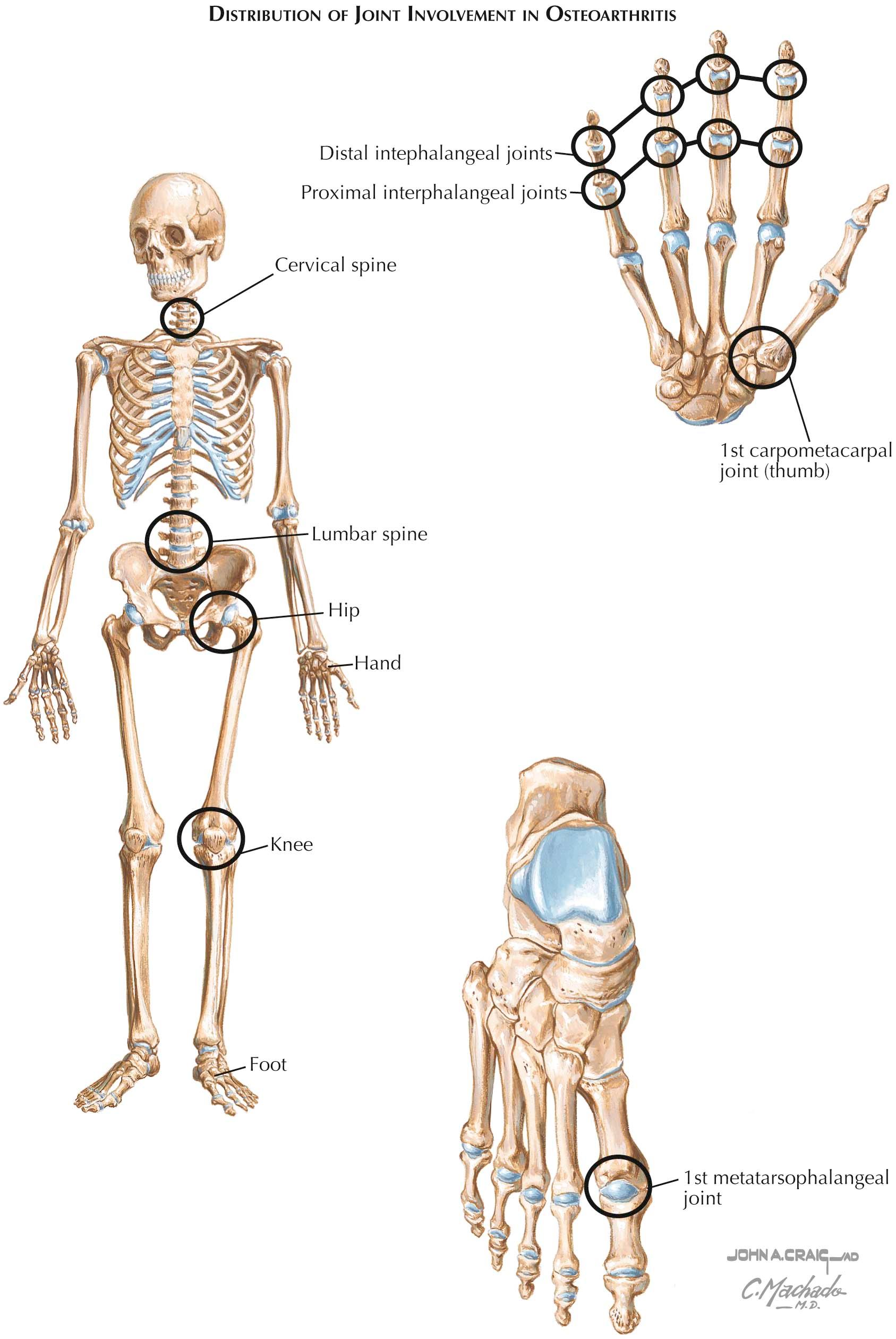
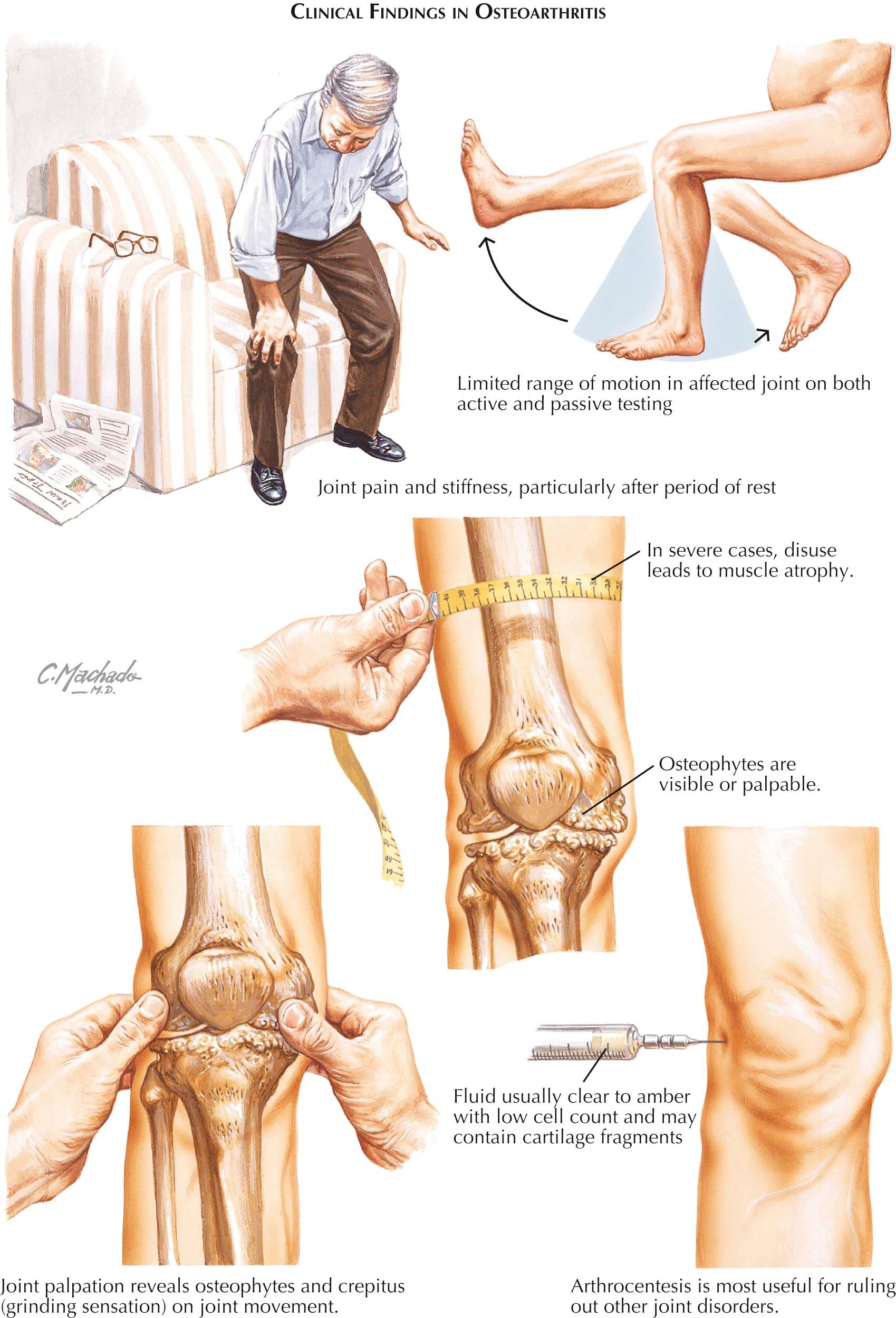
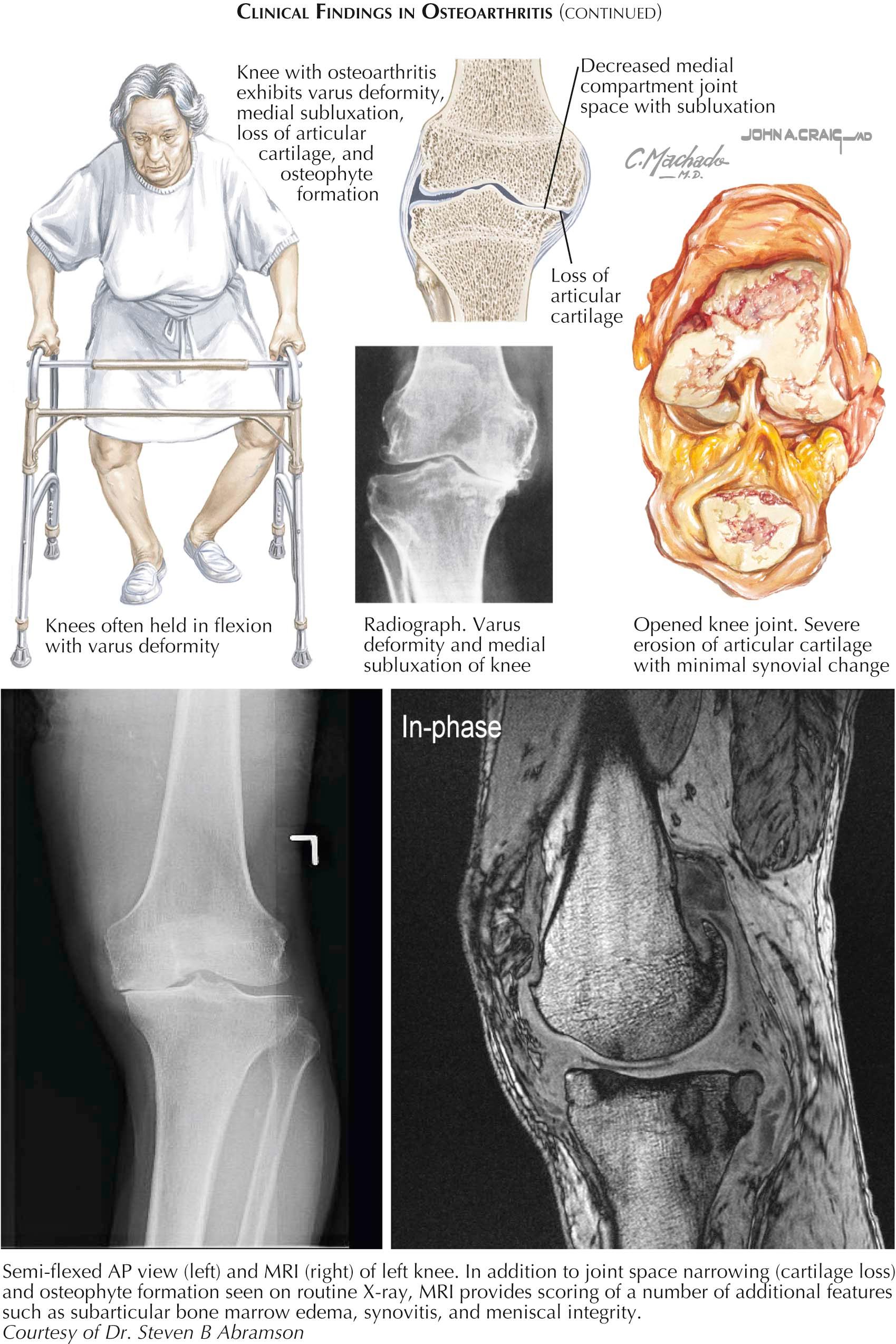
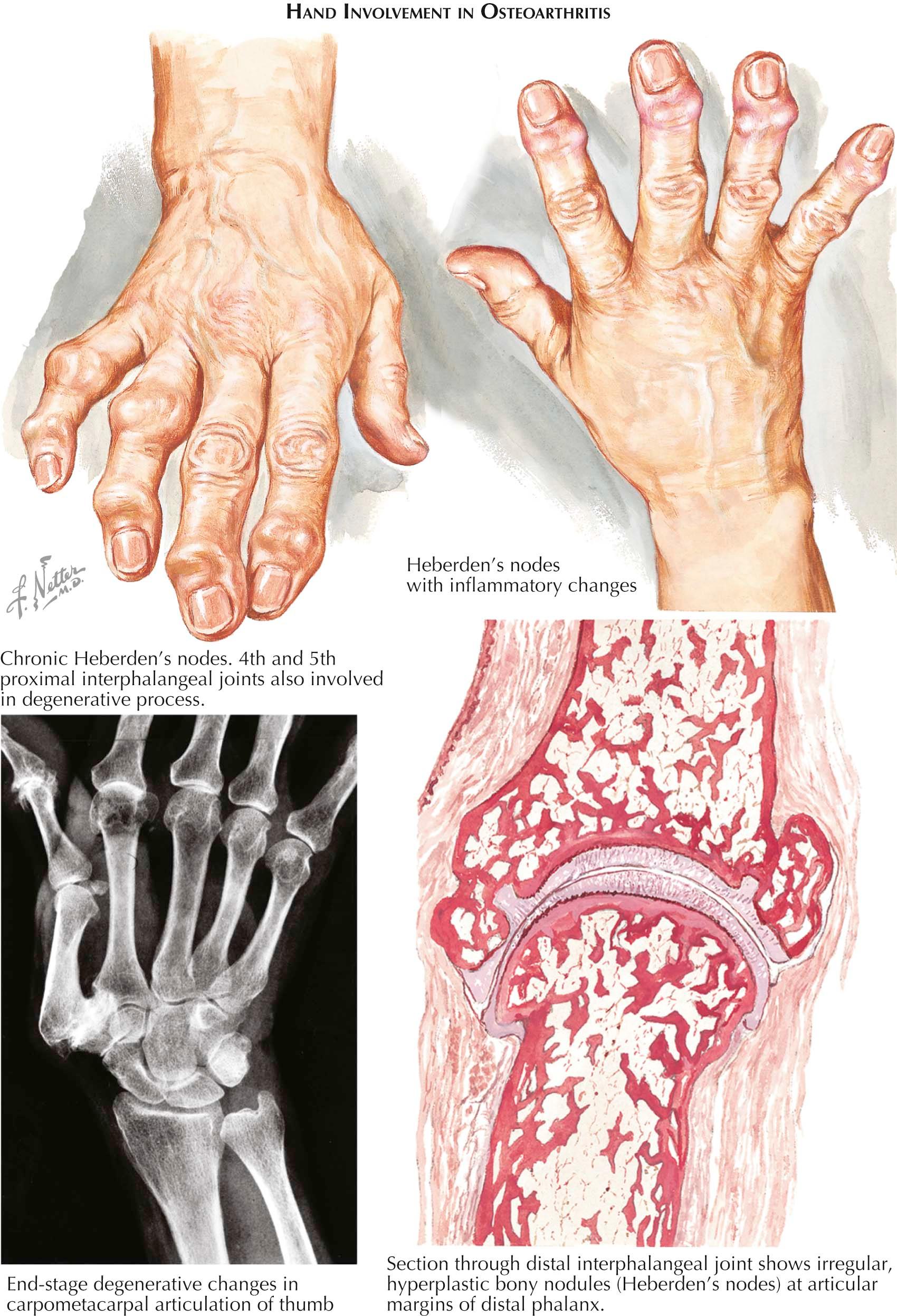
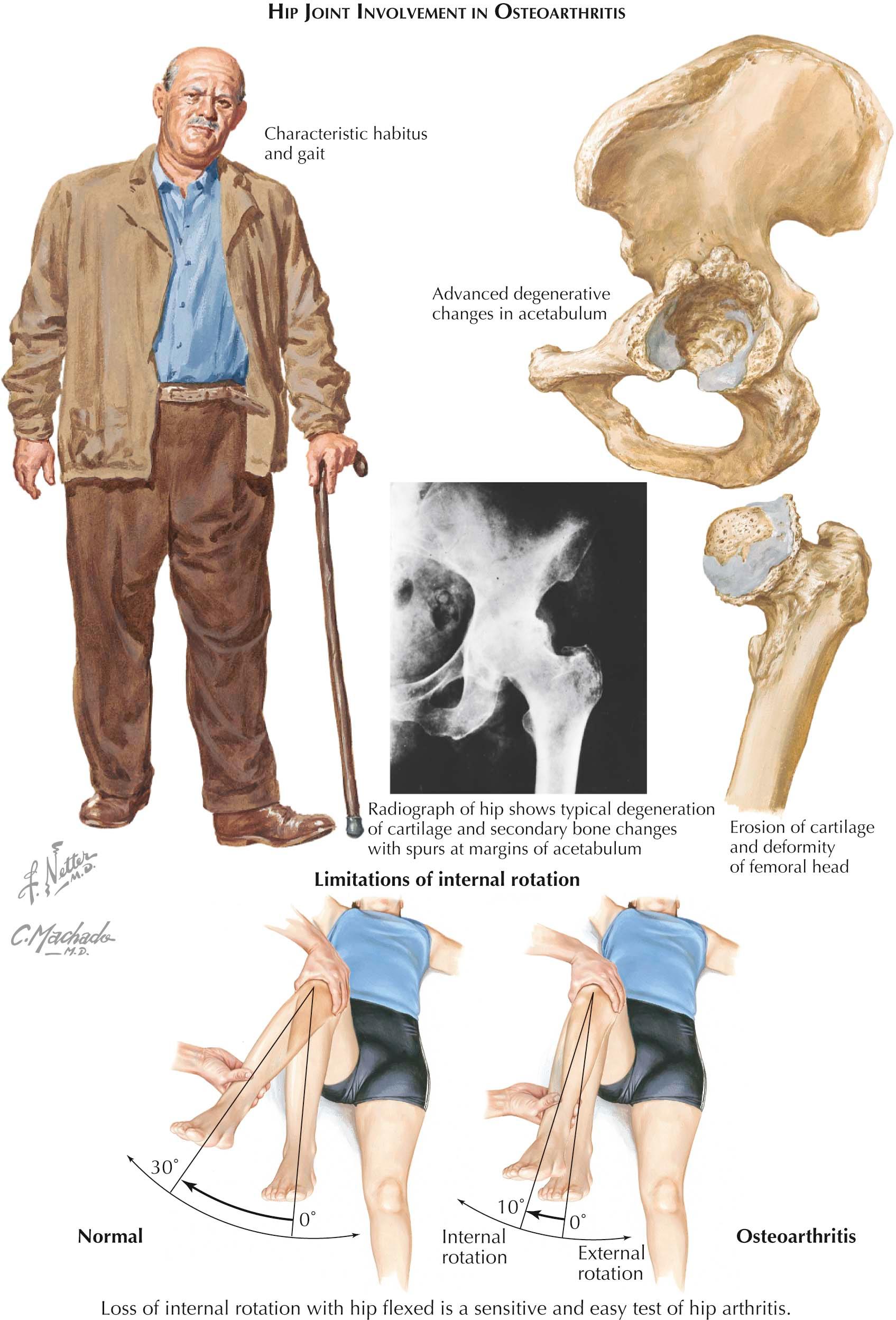
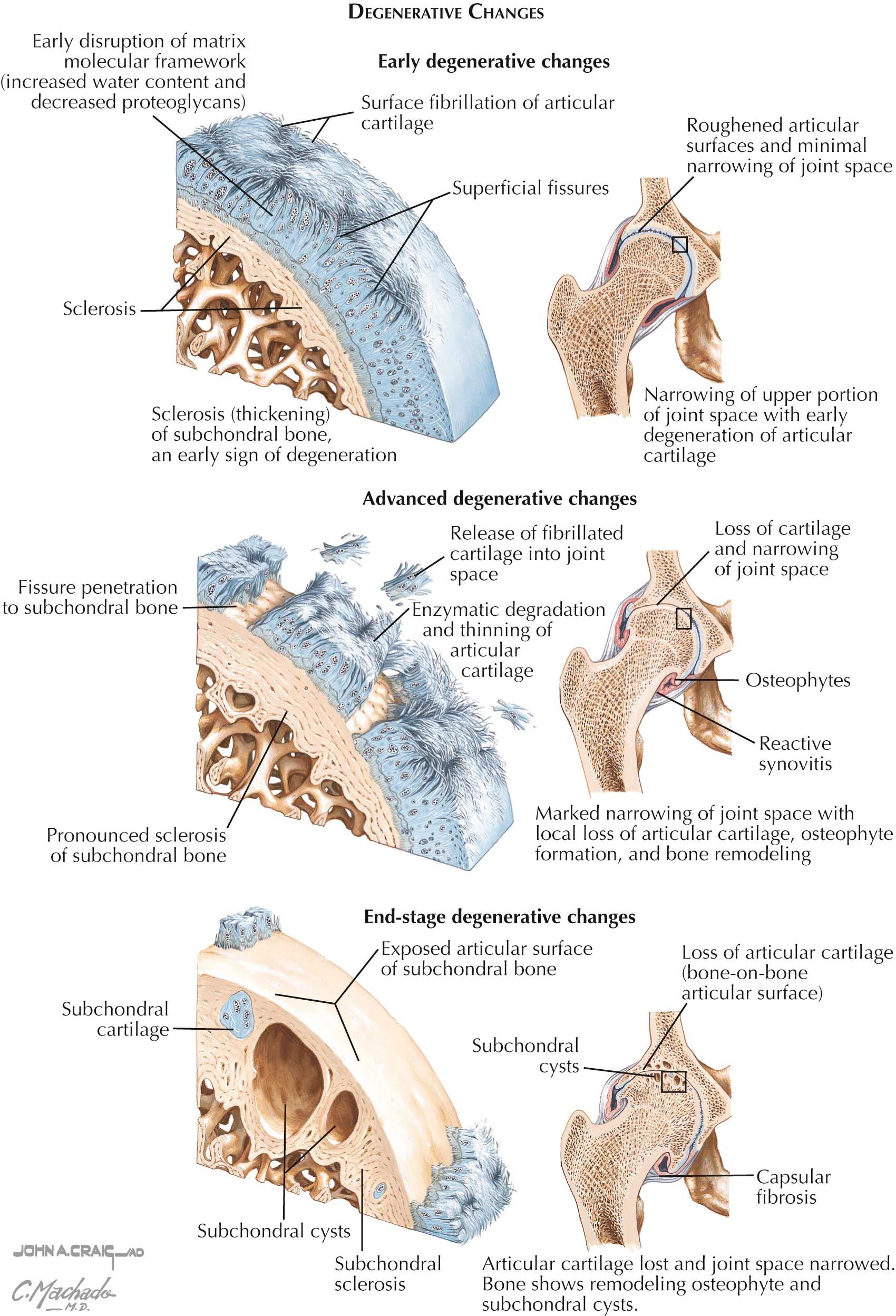
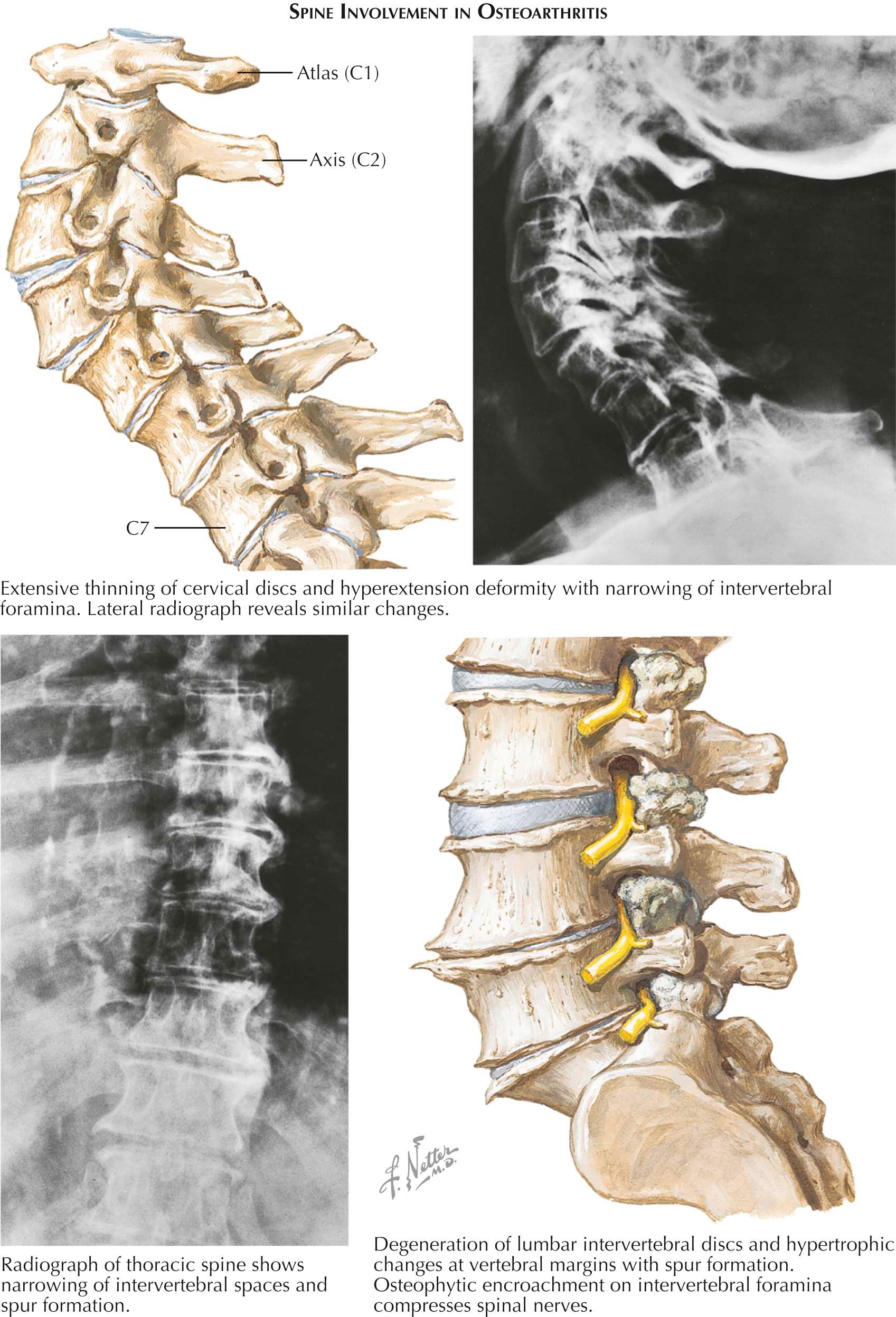
The most common joint disease, osteoarthritis, is a progressive disorder characterized by the deterioration of articular cartilage and formation of new bone in the subchondral region and at joint margins. Although commonly termed degenerative joint disease, the designation osteoarthritis emphasizes the presence of inflammation seen in the synovium in almost all cases as the disease progresses.
Many factors influence its onset and the speed of joint deterioration, including aging, gender, obesity, heredity, trauma (related to sports or occupation), joint overuse, joint instability, and malalignment. Involved basic mechanisms of pathophysiology include “normal” loading on abnormal cartilage versus “abnormal” loading on normal cartilage. Secondary osteoarthritis, the term used to designate osteoarthritis appearing as a sequel to other forms of arthritis, injury, internal derangement, or dysplasia of the joint, is not uncommonly seen in younger persons..
Evidence of osteoarthritis has been found in the skeletal remains of prehistoric animals and humans. The true prevalence is difficult to determine because mild or early osteoarthritis may be asymptomatic and is demonstrated primarily radiographically. In asymptomatic persons, osteoarthritis is often discovered accidentally on radiographs performed for other diagnostic purposes.
Unlike rheumatoid arthritis, osteoarthritis is not a systemic disease; instead, it is a process that is localized in joint structures, with involvement primarily of cartilage, bone, and synovial tissues (see Plate 5-22 ). Bone marrow lesions and synovitis add significantly to clinical symptoms.
Changes in Articular Cartilage. Pathologic changes in cartilage are characterized by alterations in proteoglycan and collagen. This leads to a softening of the cartilage followed by fraying and fibrillation; cracks develop extending more deeply into the cartilage. Clusters of chondrocytes proliferate in efforts at repair. As degeneration progresses, the entire cartilage becomes thinner and the surface becomes rough from the focal ulcerations. Eventually, the articular surface is denuded of cartilage. Because cartilage has no blood supply, regeneration is limited.
Changes in Bone. New bone forms at two sites: in subchondral bone and at joint margins. In subchondral tissue, the new bone grows chiefly beneath the eroded cartilage surface, thus eventually becoming the articular surface. The new bone becomes smooth, glistening, and sclerotic, or eburnated.
The most characteristic pathologic feature is the growth of osteophytes at the margins of affected joints (spur formation). The osteophyte, which consists of bone growing from the joint margin, usually follows the contour of the articular surface within the capsule and ligamentous attachments.
Changes in Soft Tissue. The synovial and capsular tissues may show mild-to-moderate inflammation and fibrous thickening in joints severely deranged by extensive damage to cartilage and bone. These soft tissue changes are associated with the stress, strain, and mechanical irritation that are secondary to the degenerative changes.
The pathogenesis of osteoarthritis involves a number of factors, any one or a number of which might be operative in a given patient. As noted, many tissues are involved in the process, including subchondral bone, synovium, cartilage, and bone at the joint periphery, as well as ligaments and muscles. Not well recognized is the presence of synovial inflammation as the disease progresses, related to inflammatory mediators such as IL-1, TNF-α, and prostaglandins. Proteases targeted to proteoglycans and collagen play an important role in joint breakdown. Obesity has a strong relationship to osteoarthritis, especially in the presence of additional factors such as joint instability and malalignment. Genetic predisposition to osteoarthritis has been well defined, especially in women with the development of Heberden's nodes, the nodular swellings at the terminal joints (distal interphalangeal joints) of the fingers. There is a suggestion that aging per se may play an etiologic role in the form of advanced glycation end-products that lead to formation of cross-links between sugars and proteins, making the cartilage more susceptible to injury from other risk factors.
Microtrauma caused by daily “wear and tear” on articular cartilage in weight-bearing joints likely contributes significantly to the degenerative process. As noted, mechanical factors that predispose to osteoarthritis are excessive body weight, postural abnormalities, and joint instability. Alterations in joint architecture, such as acetabular dysplasia or pistol-grip deformity of the hip, may play a role in development of osteoarthritis in this joint.
The signs and symptoms of osteoarthritis depend on the joint or joints affected (see Plate 5-22 ). Most commonly involved are the weight-bearing joints (see Plate 5-23 ) and small joints of the hand.
Pain and restricted movement are the major clinical manifestations. The patient is usually comfortable at rest but finds weight bearing and moving the affected joints painful. Aching during rainy weather, stiffness after inactivity, and crepitation are other frequent complaints.
Physical examination reveals tenderness, pain and crepitation with joint movement, and, usually, a limited range of motion. Although signs of synovitis—warmth and erythema over the joint—are usually limited or absent, swelling exists in association with bony hypertrophy or if there is a joint effusion.
Of the large joints, the knee is most often affected. Because the knee is so crucial in the lever action of the leg and in ambulation, osteoarthritis in this joint can be both very painful and disabling, especially when it is bilateral (see Plate 5-24 ). The medial compartment of the knee is usually more severely damaged than the lateral compartment. The structural damage in the joint causes pain, restriction of motion, and crepitation. Subluxation and angular deformities are late sequelae.
Become a Clinical Tree membership for Full access and enjoy Unlimited articles
If you are a member. Log in here